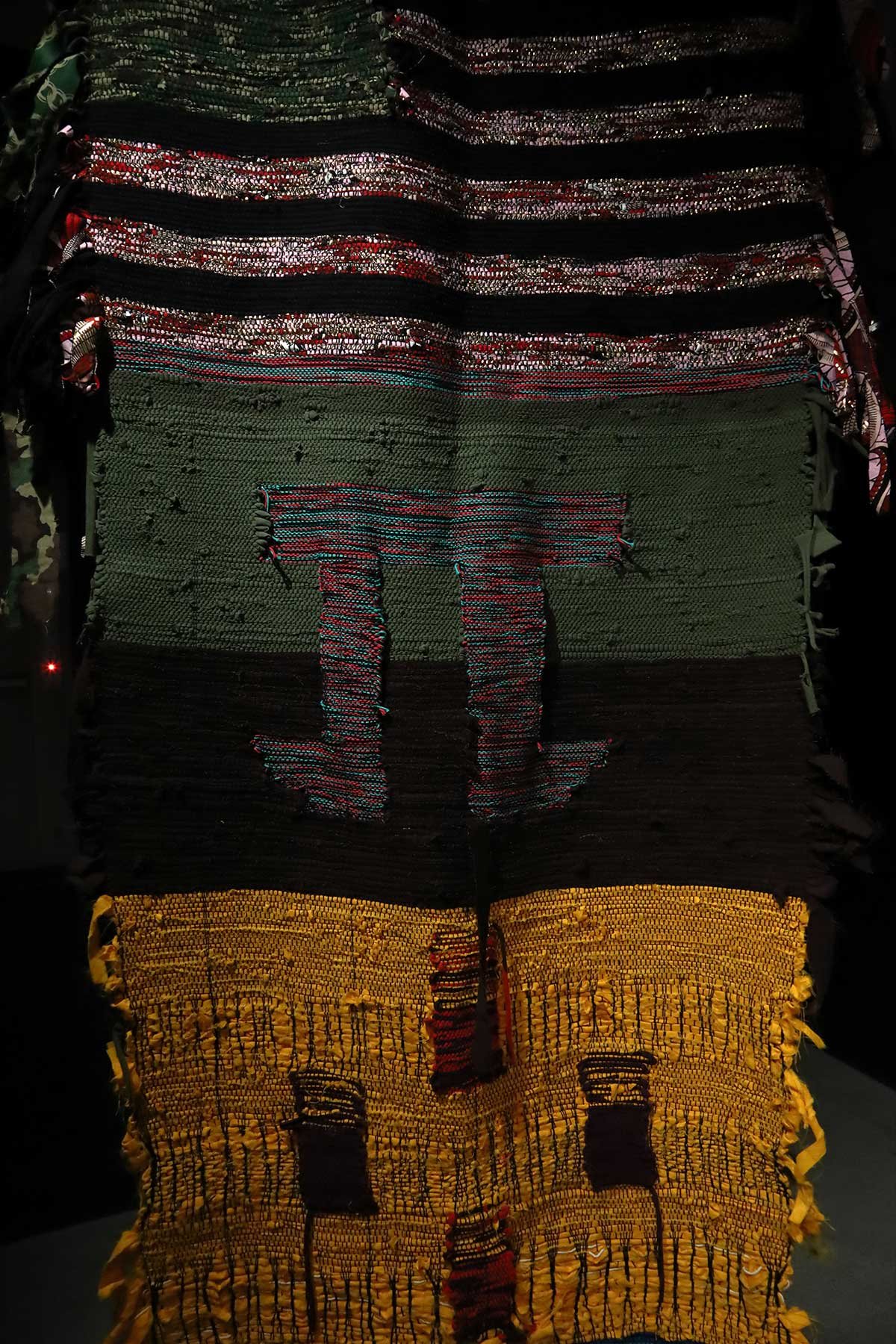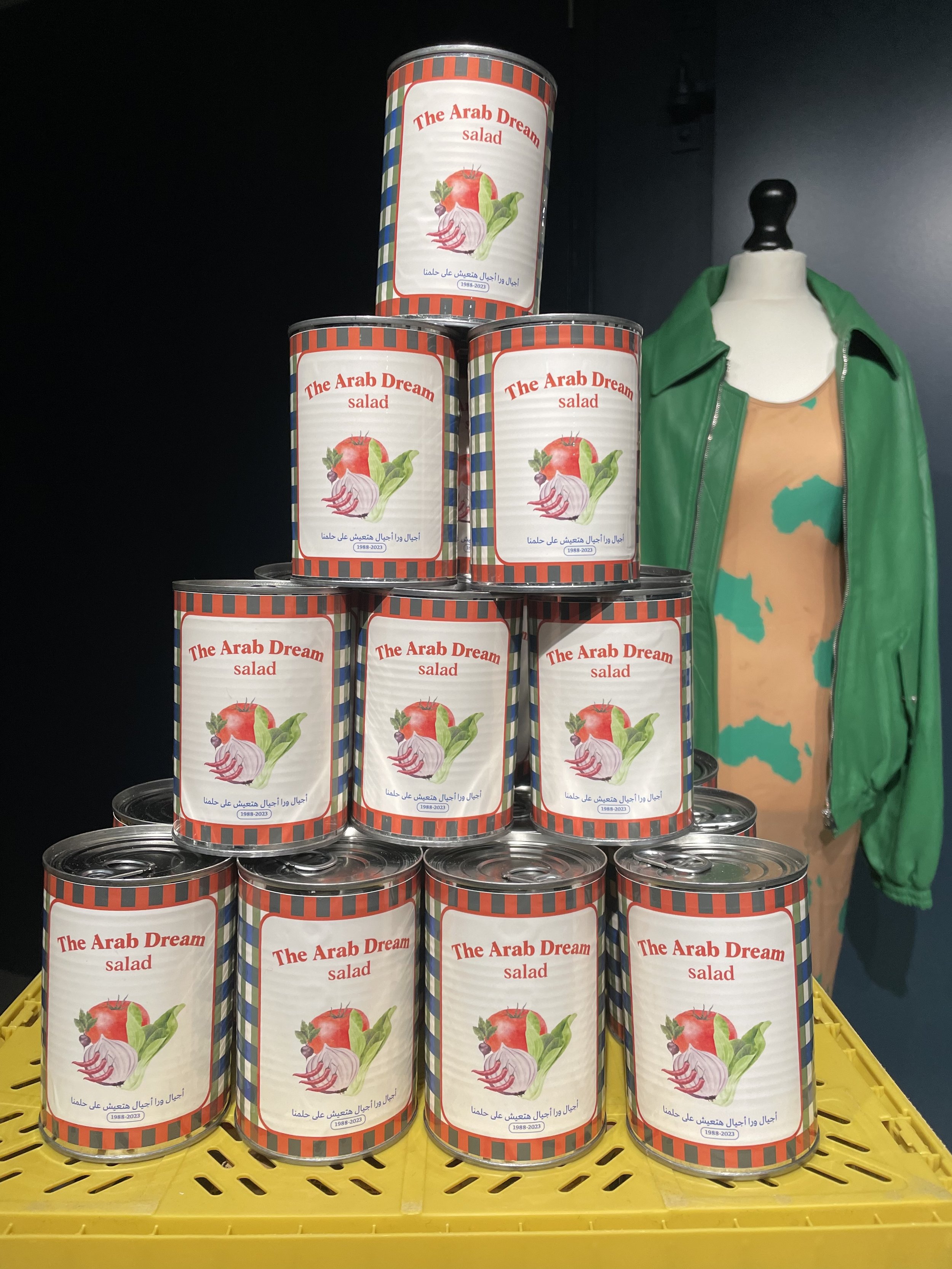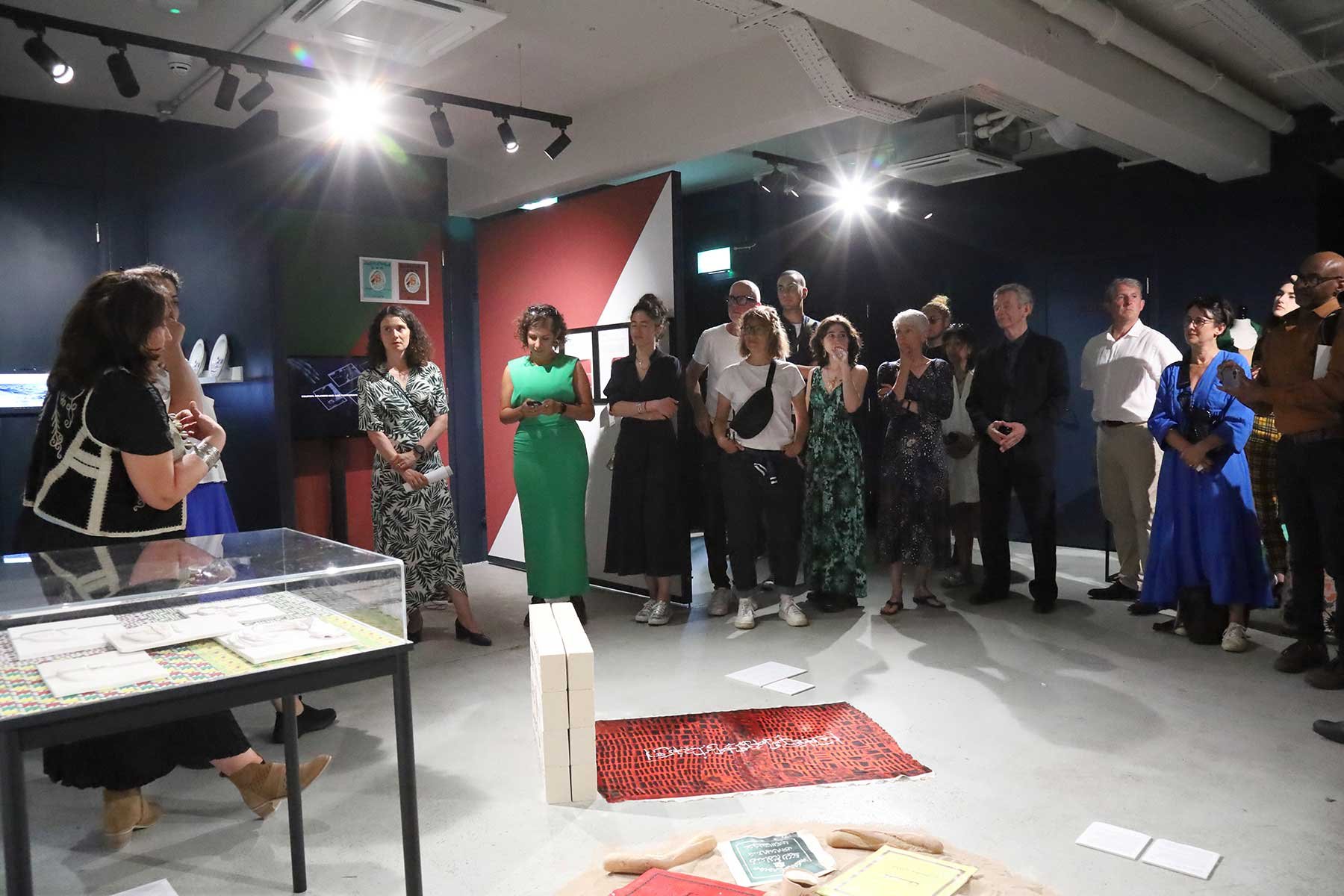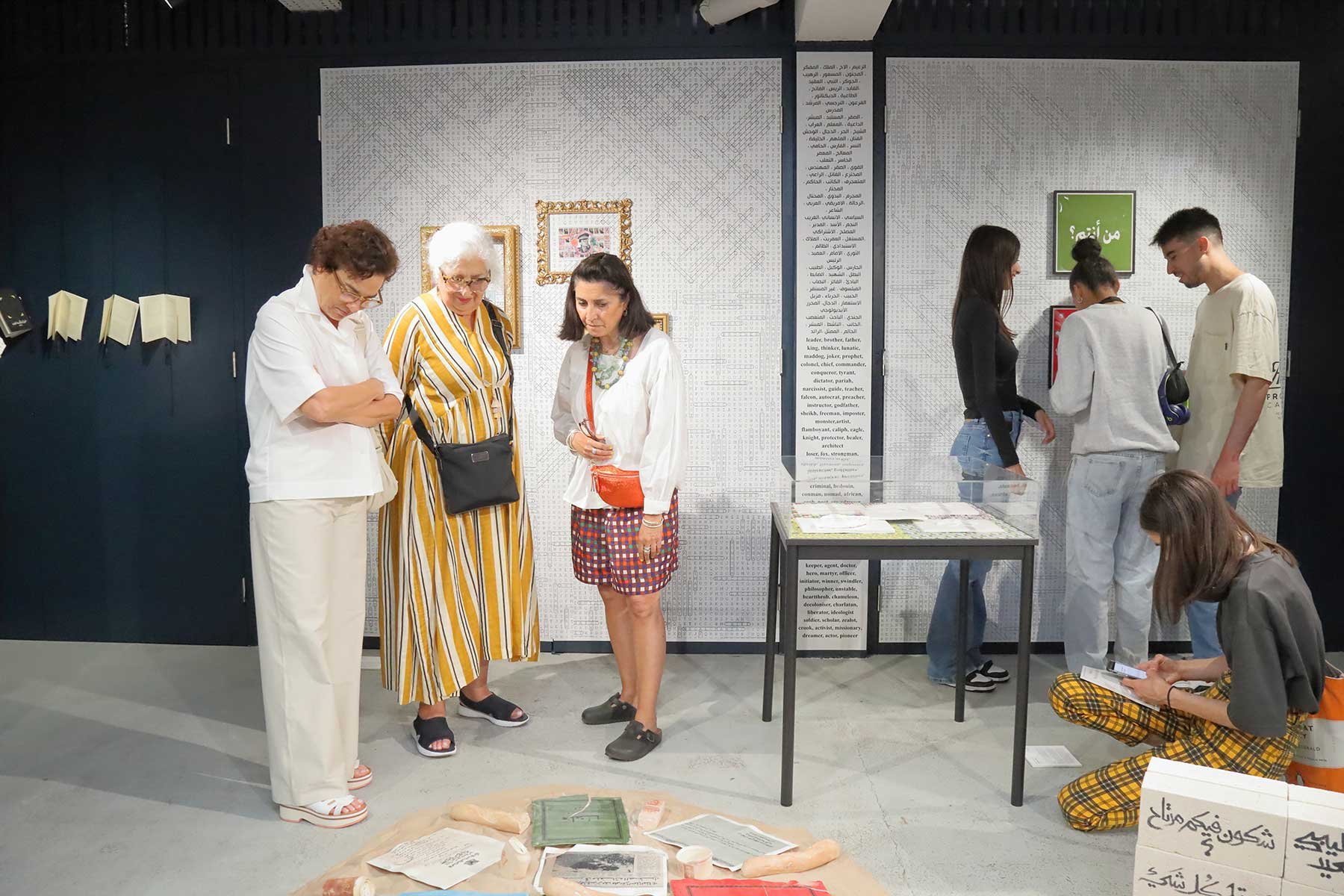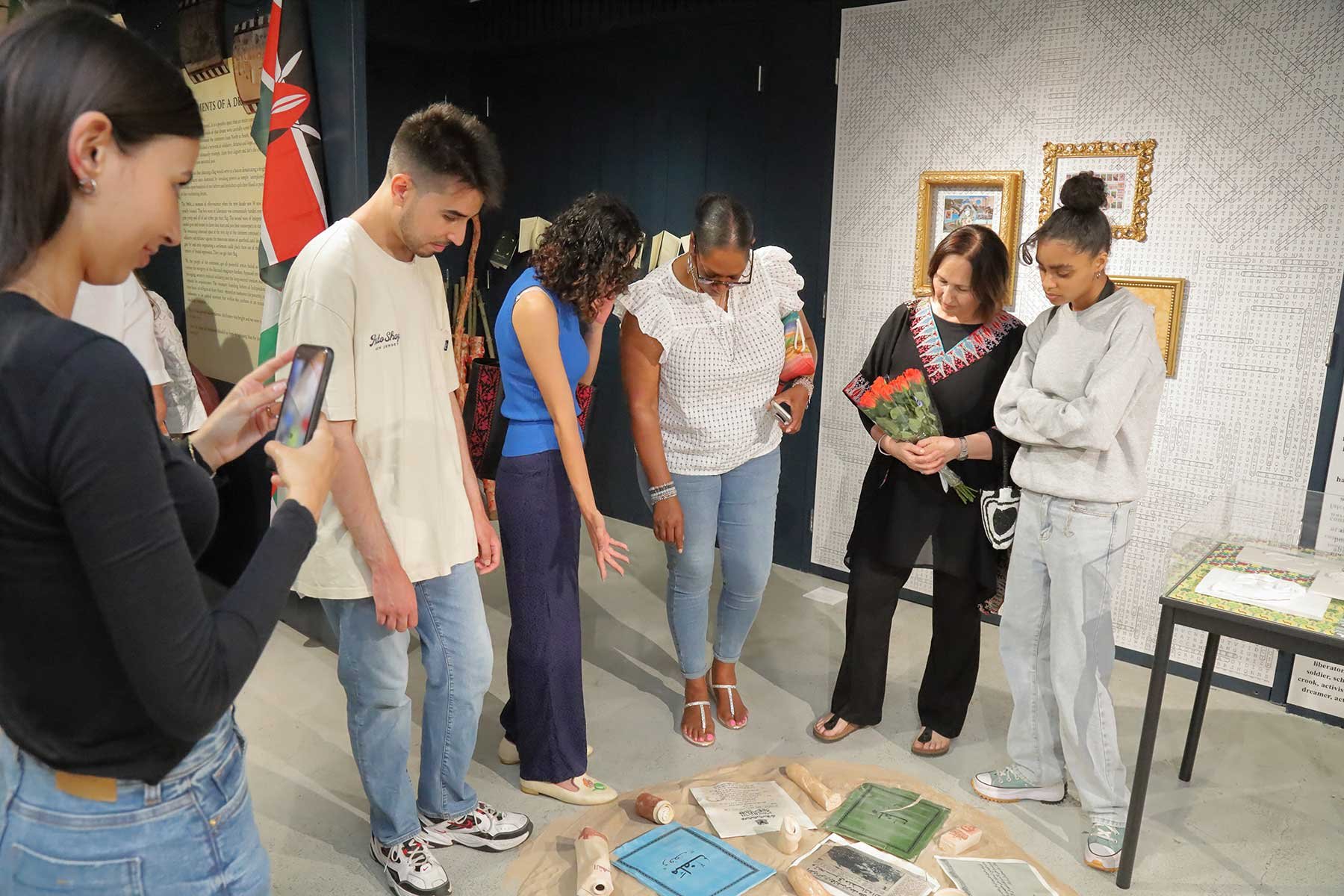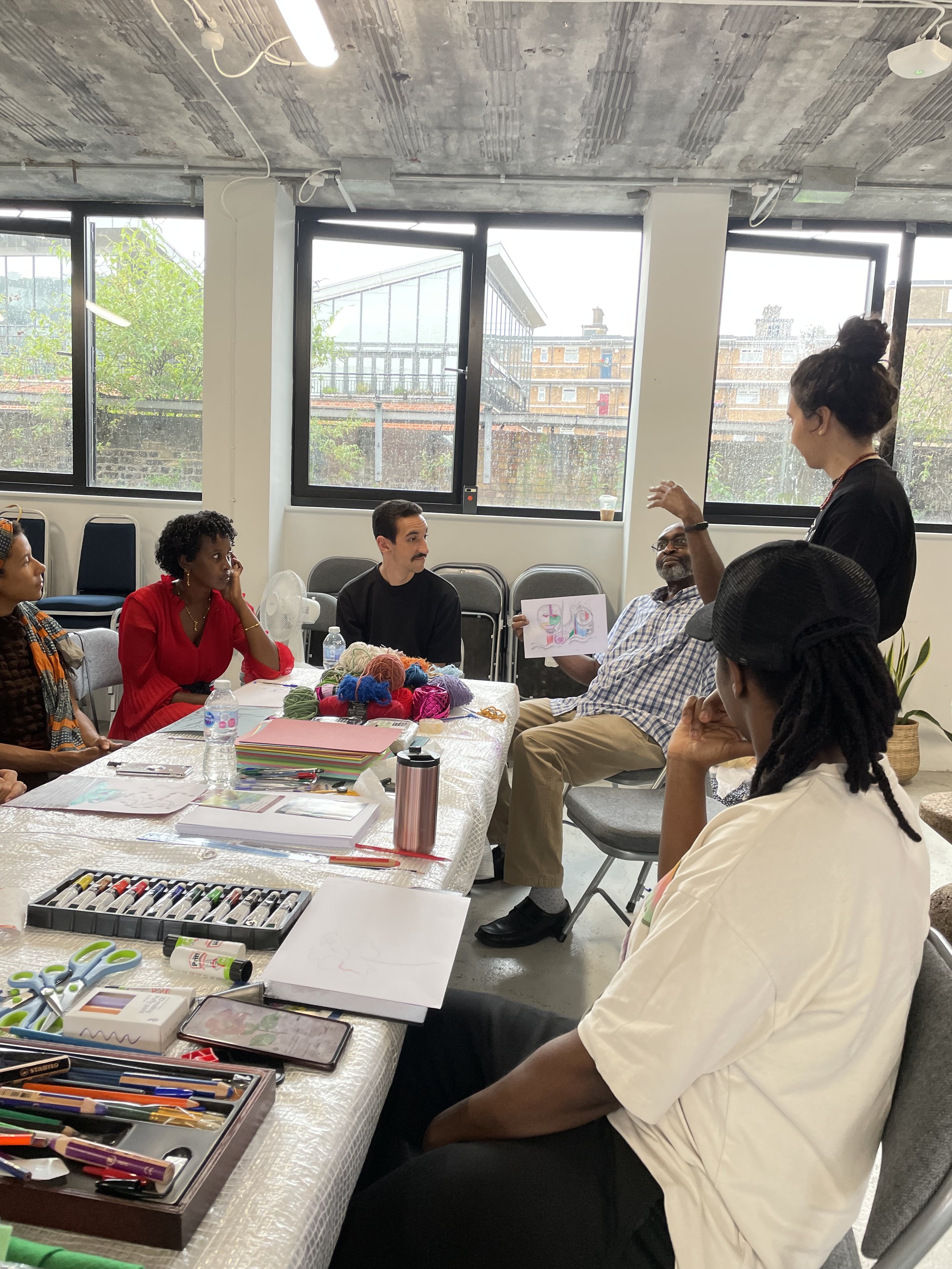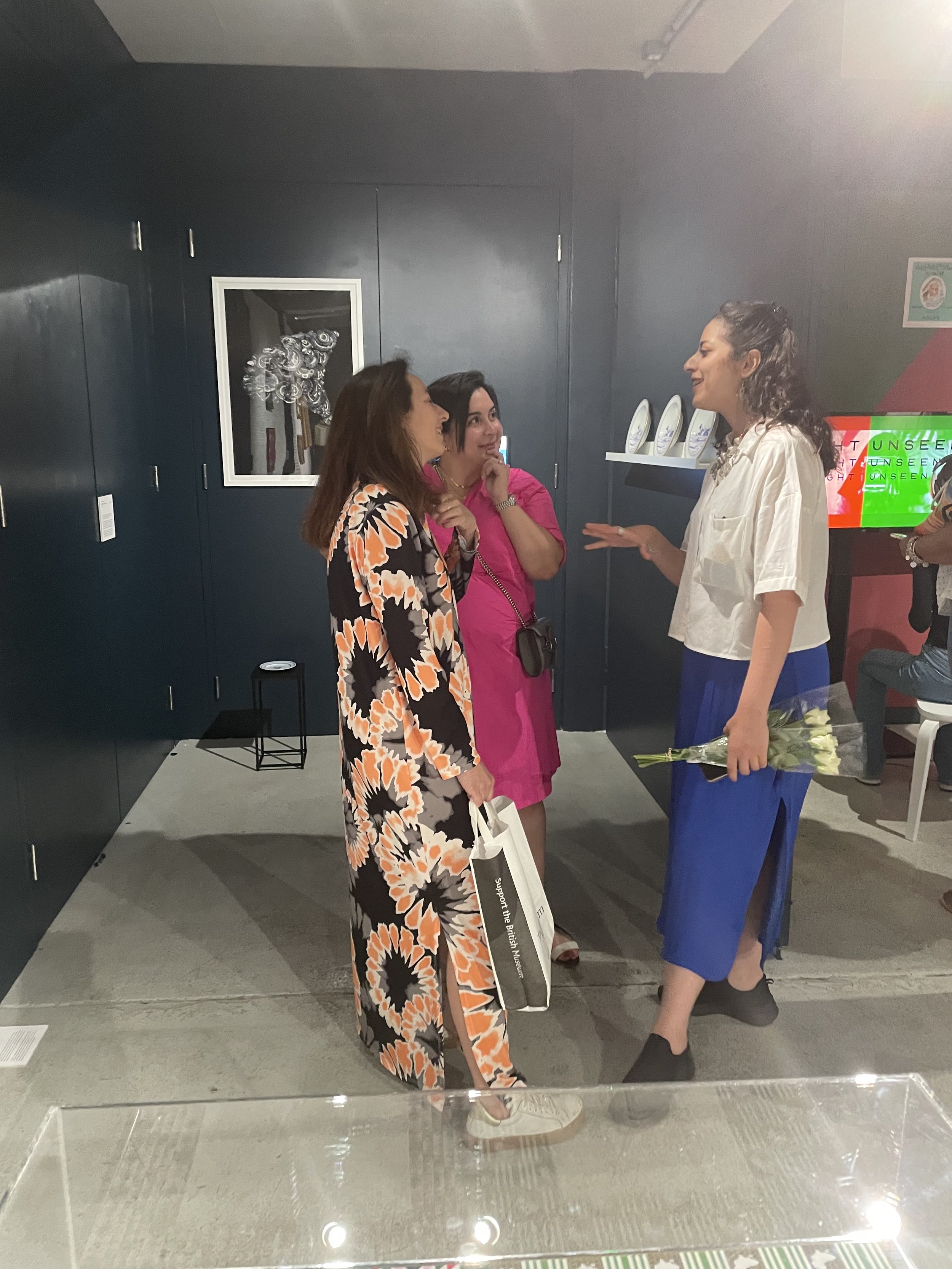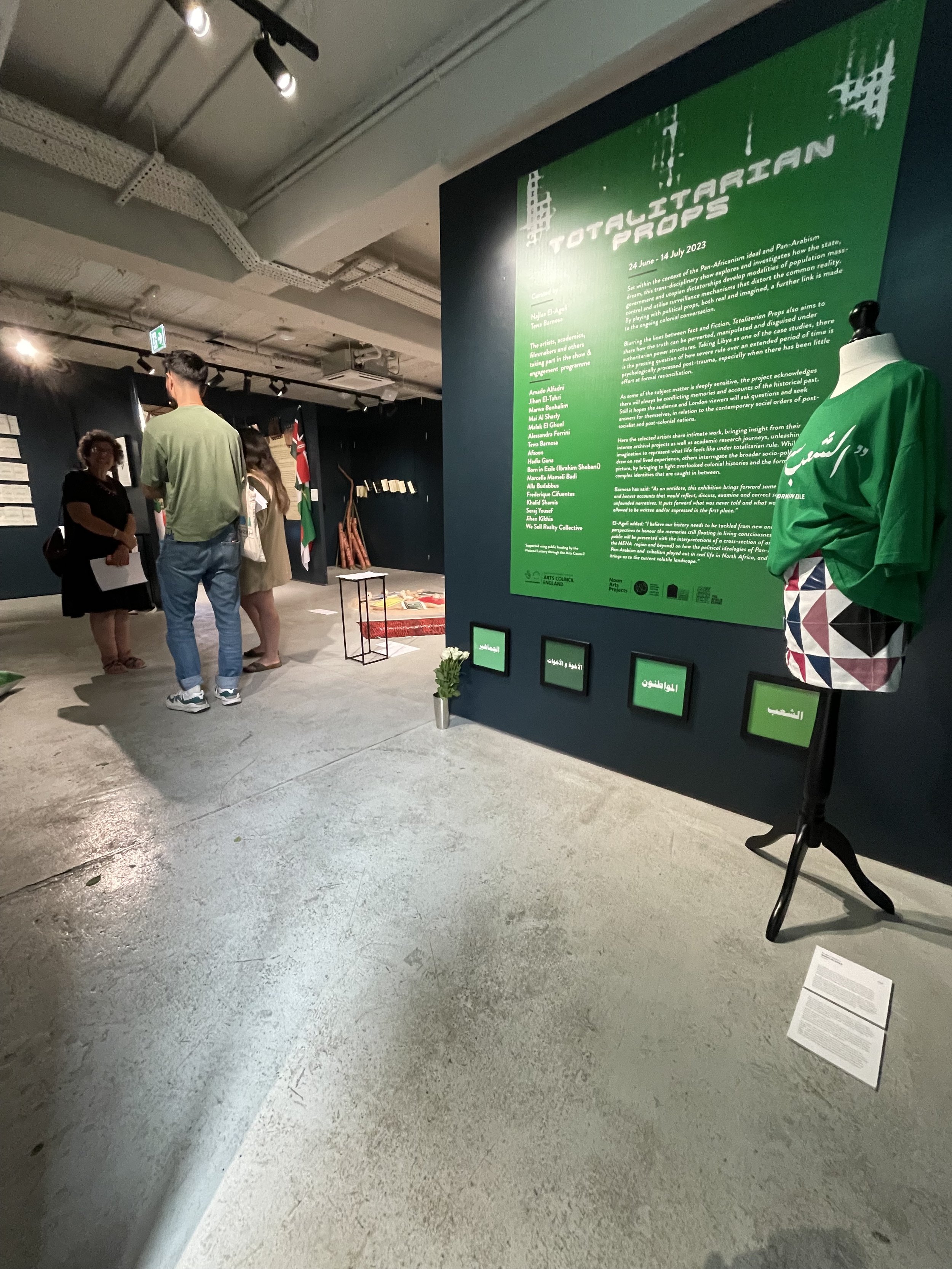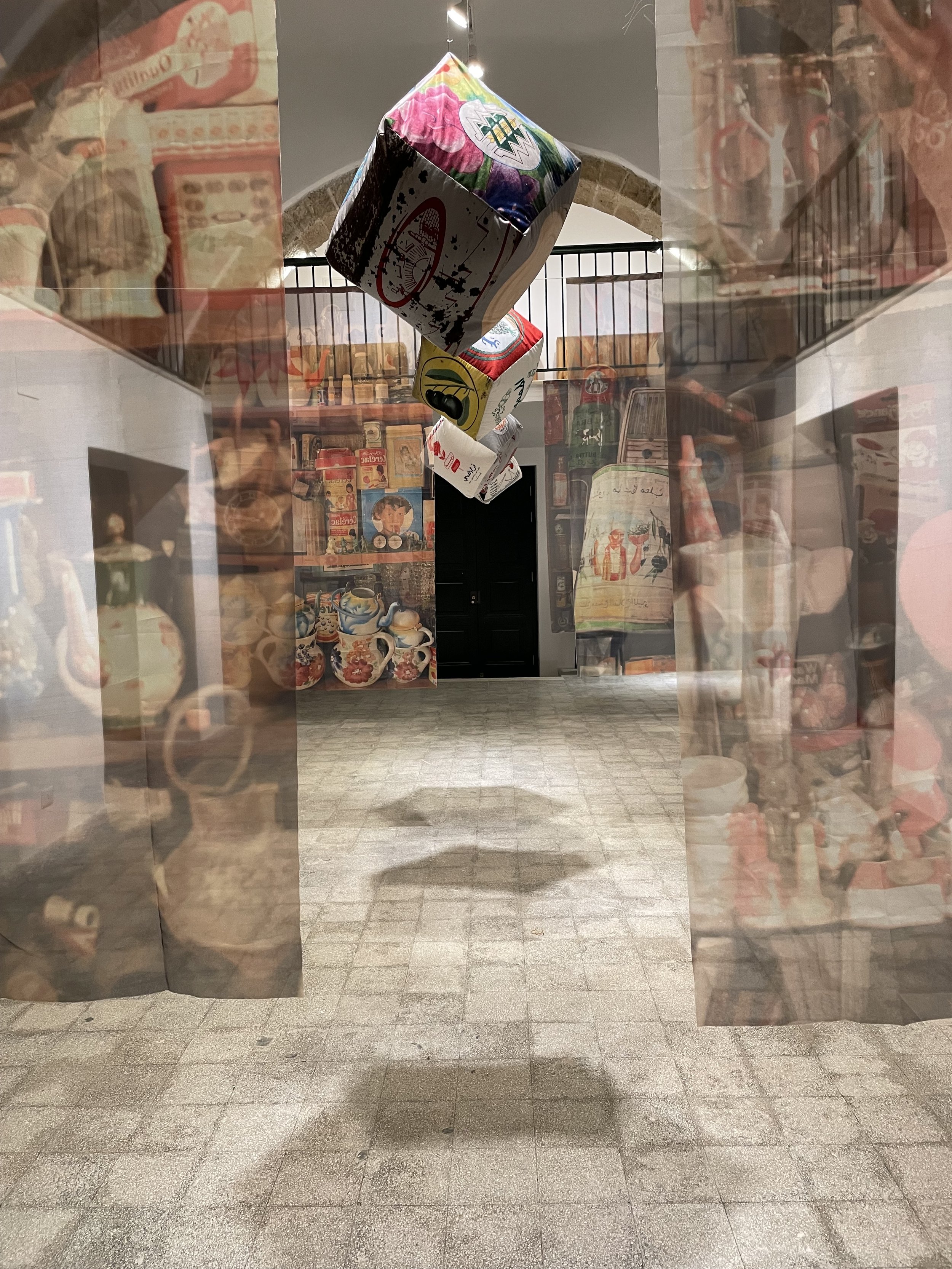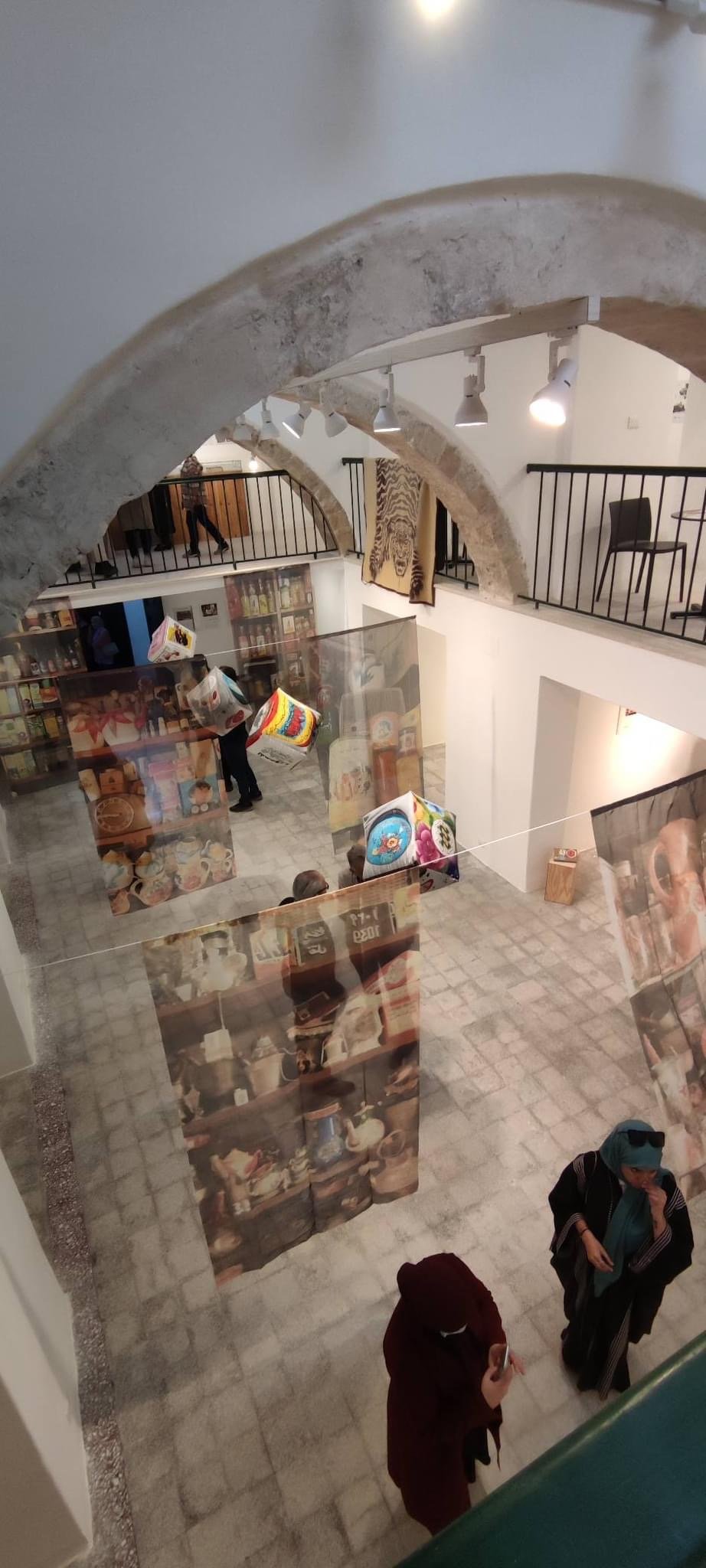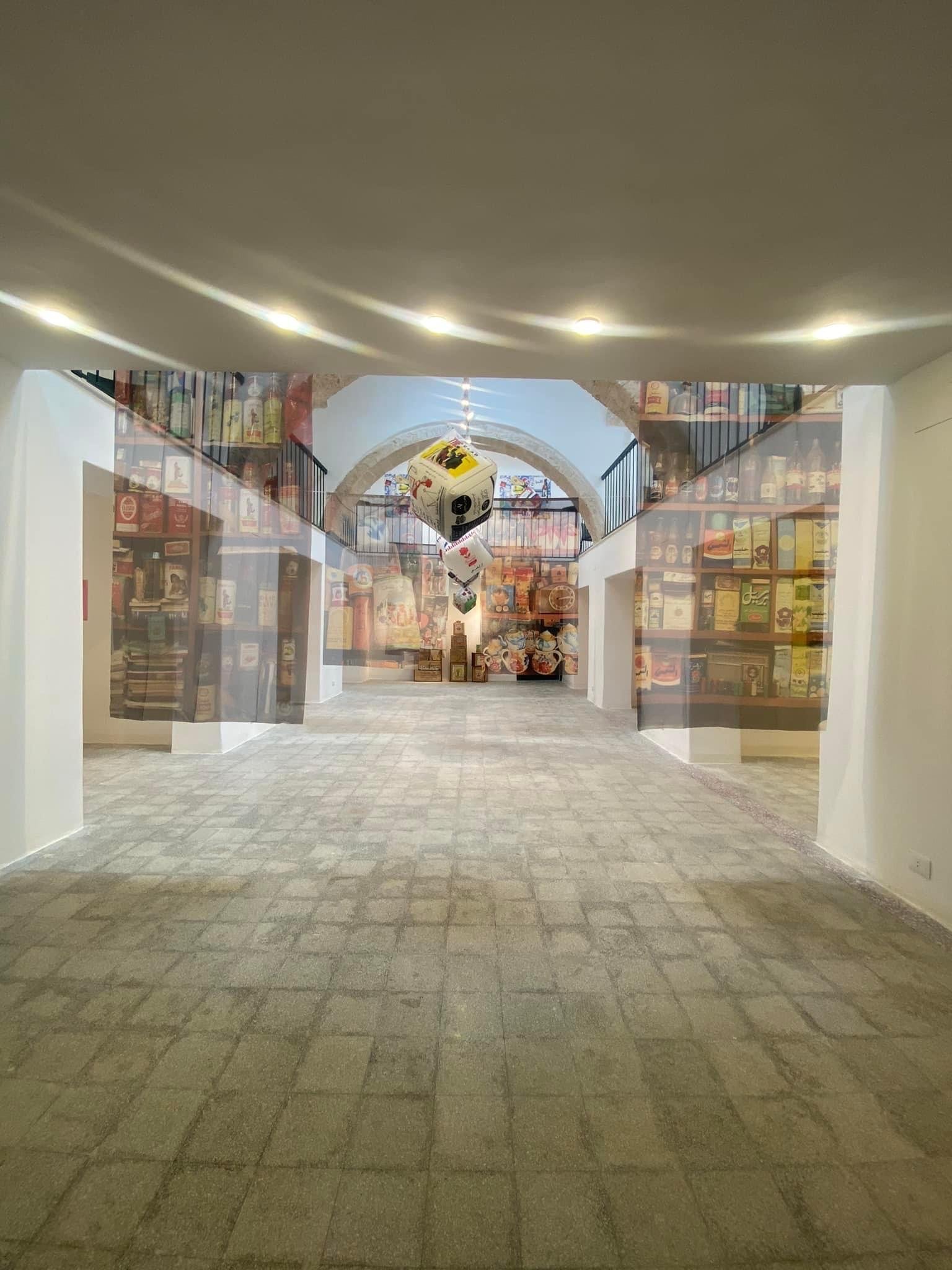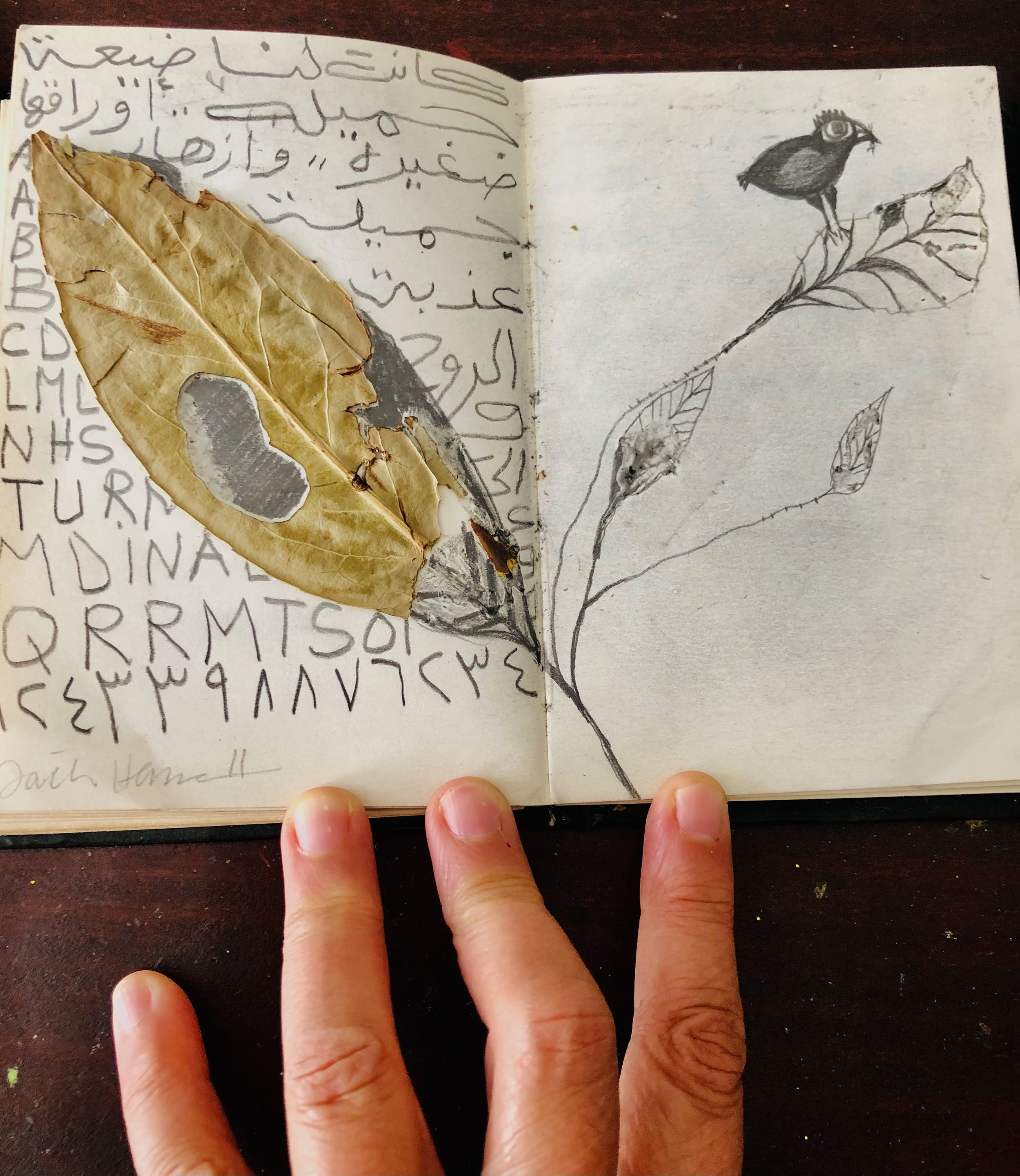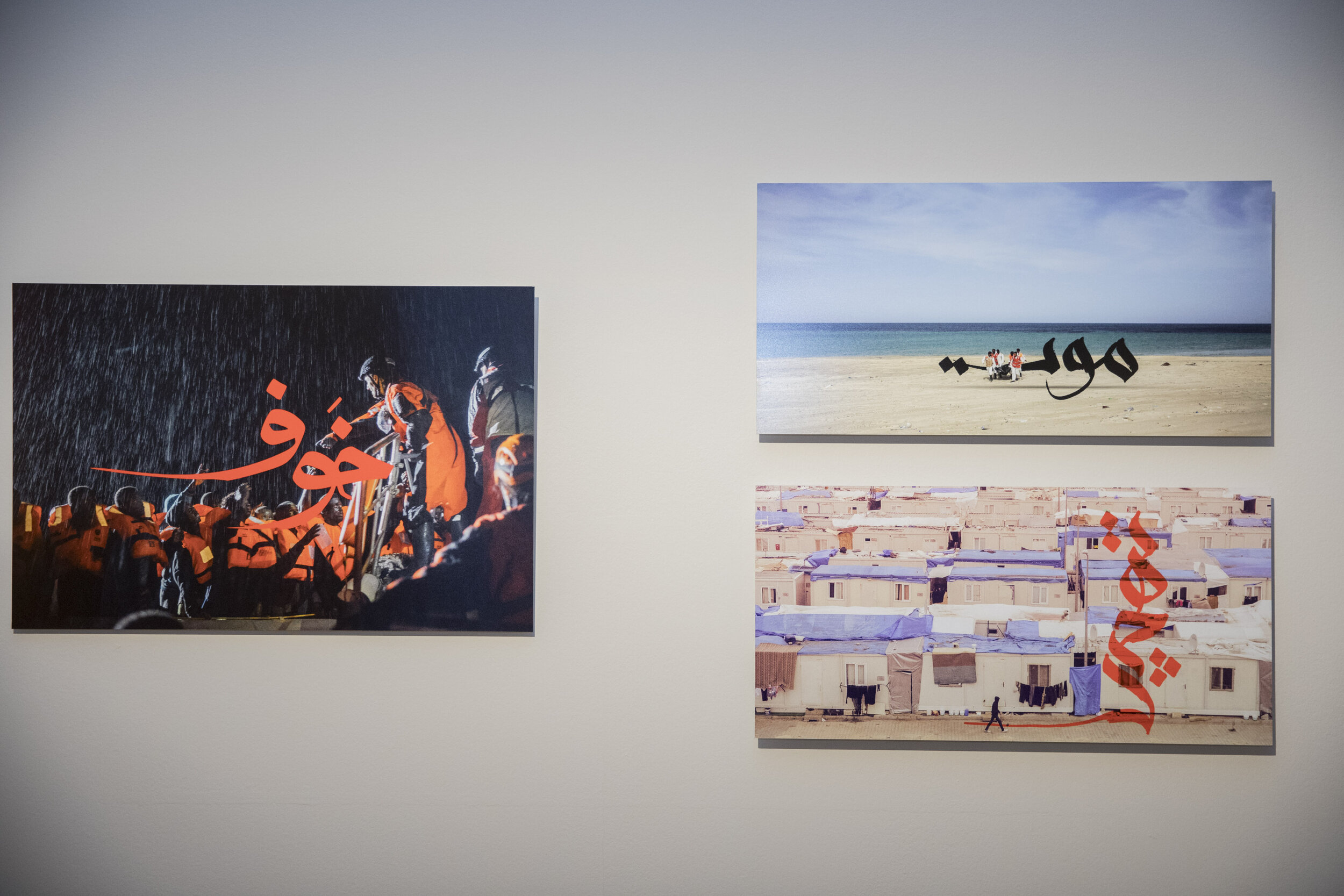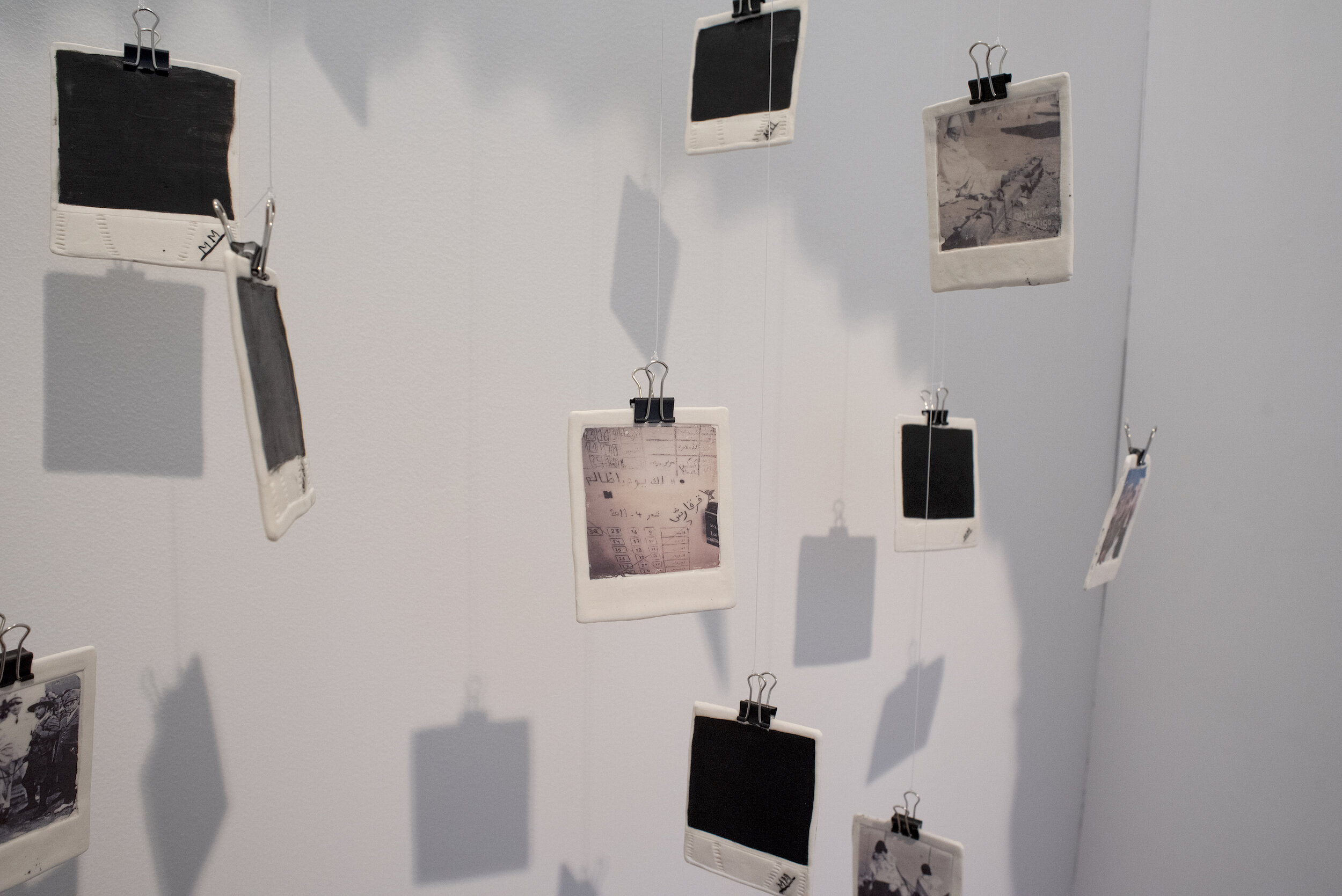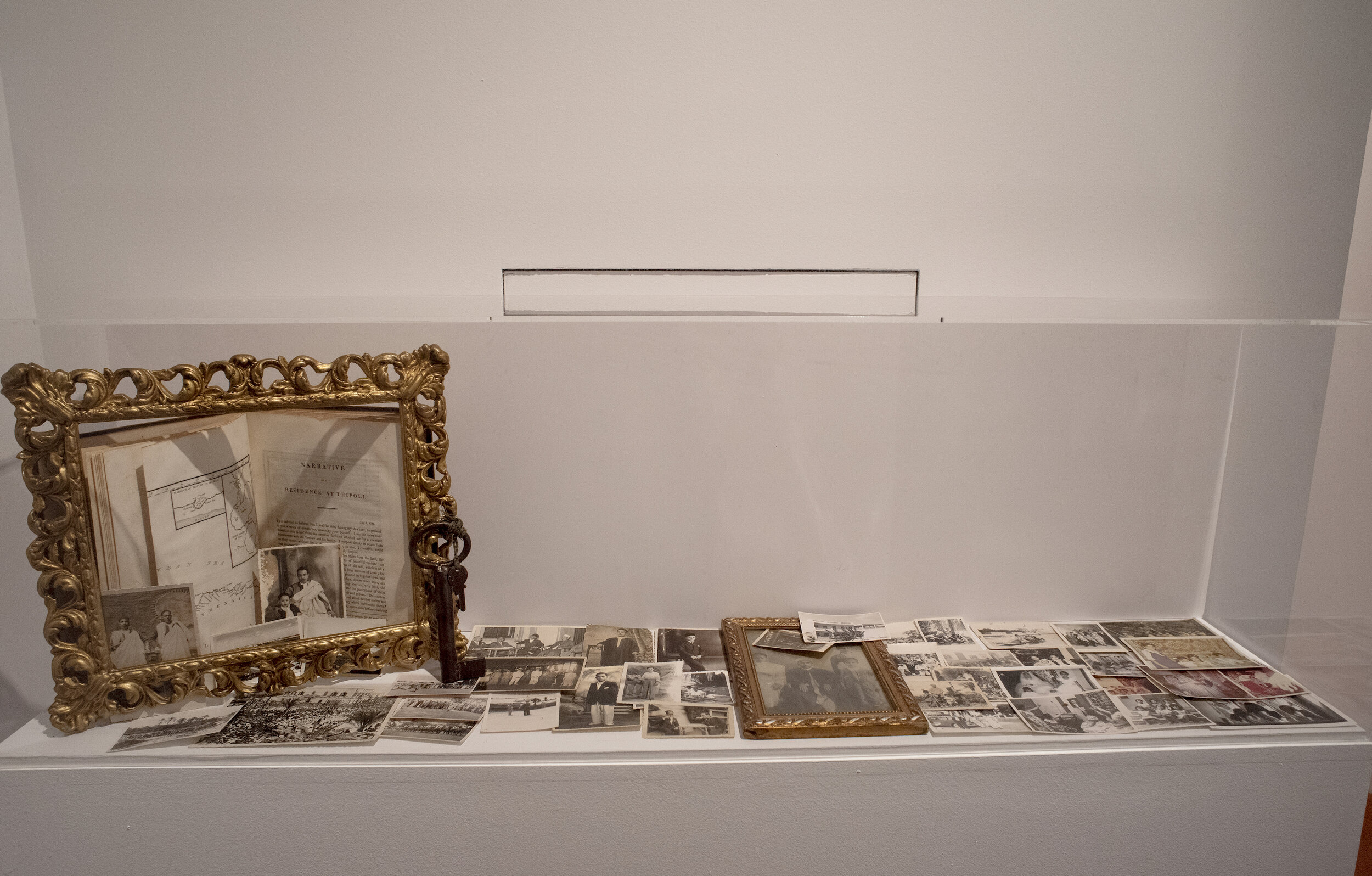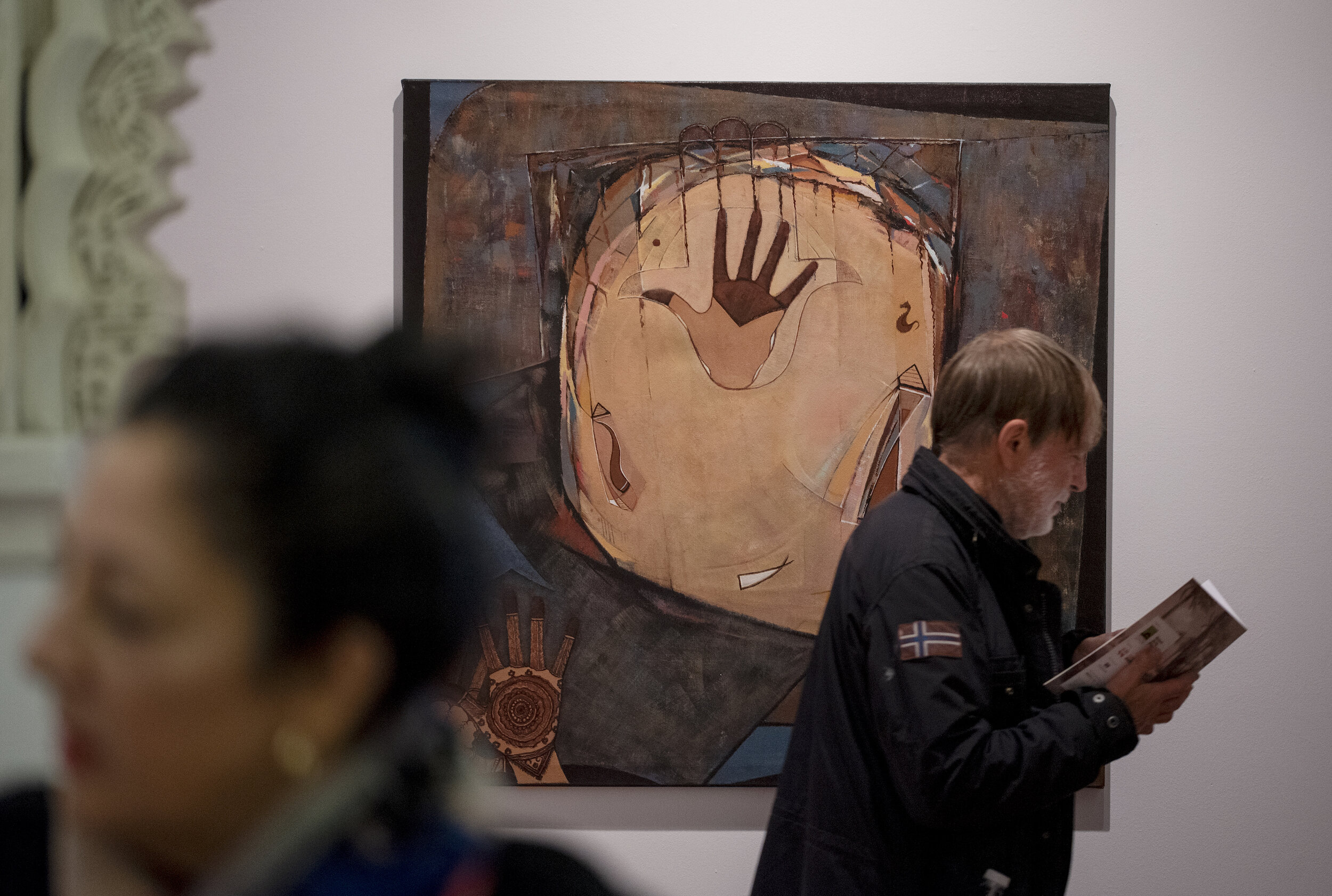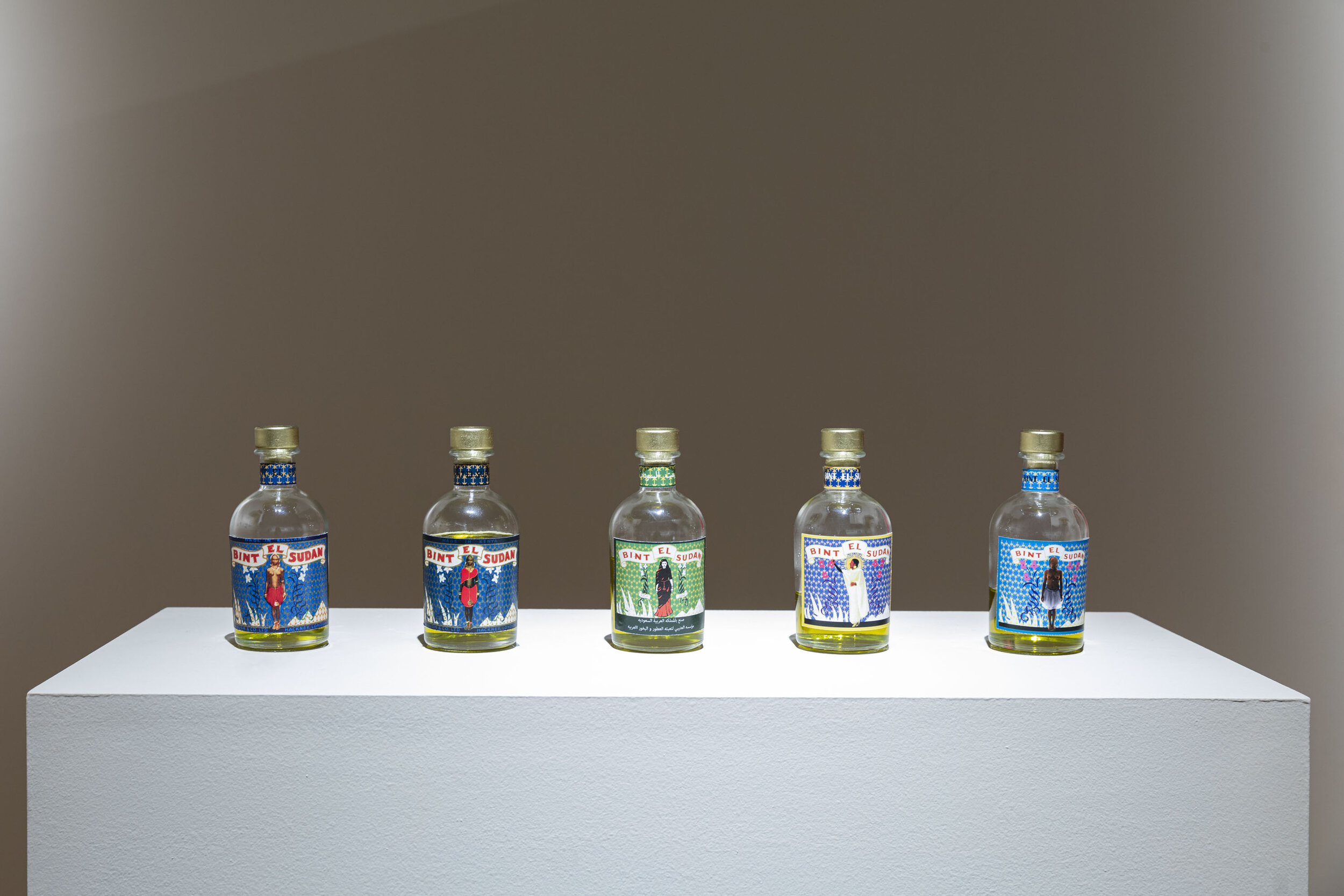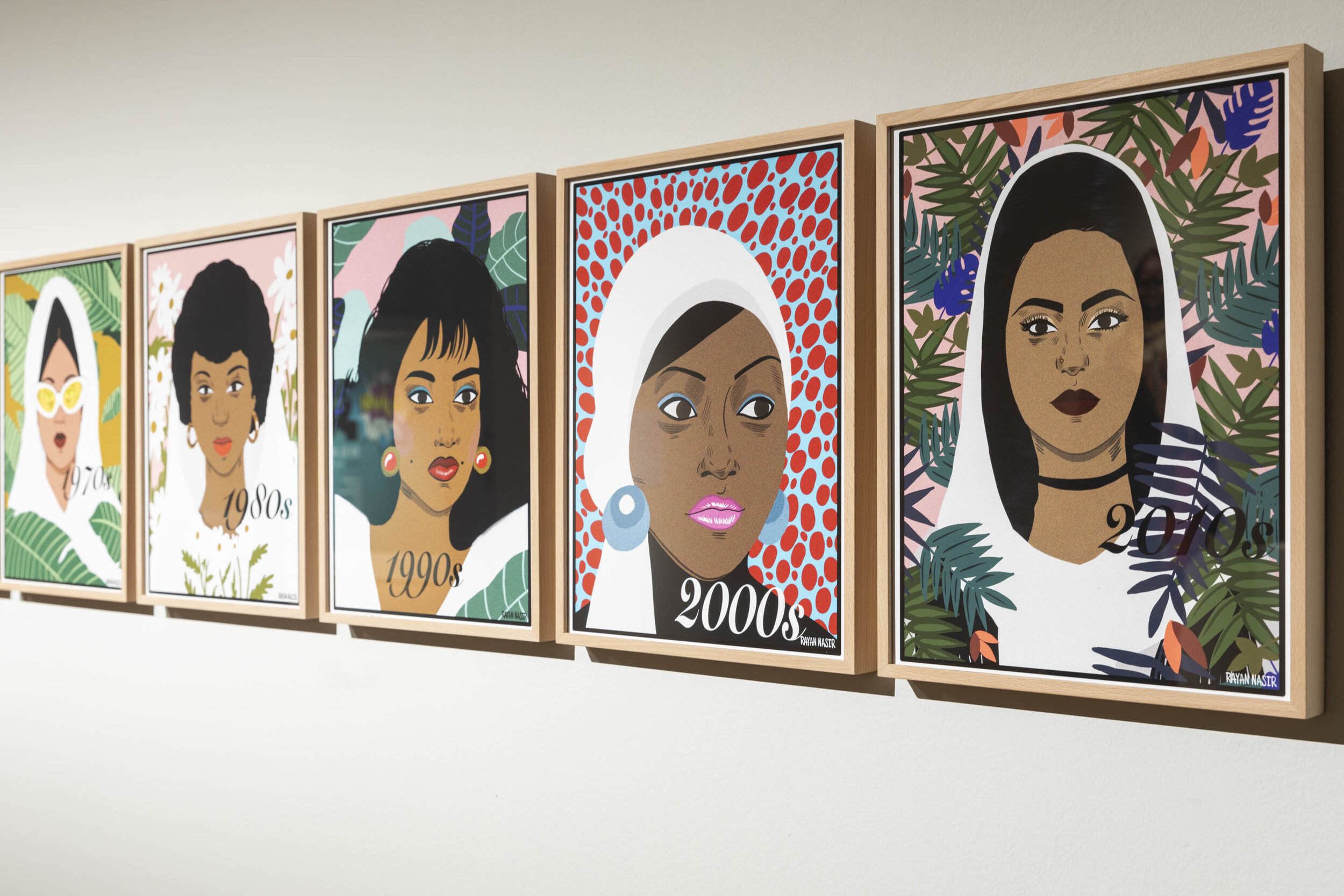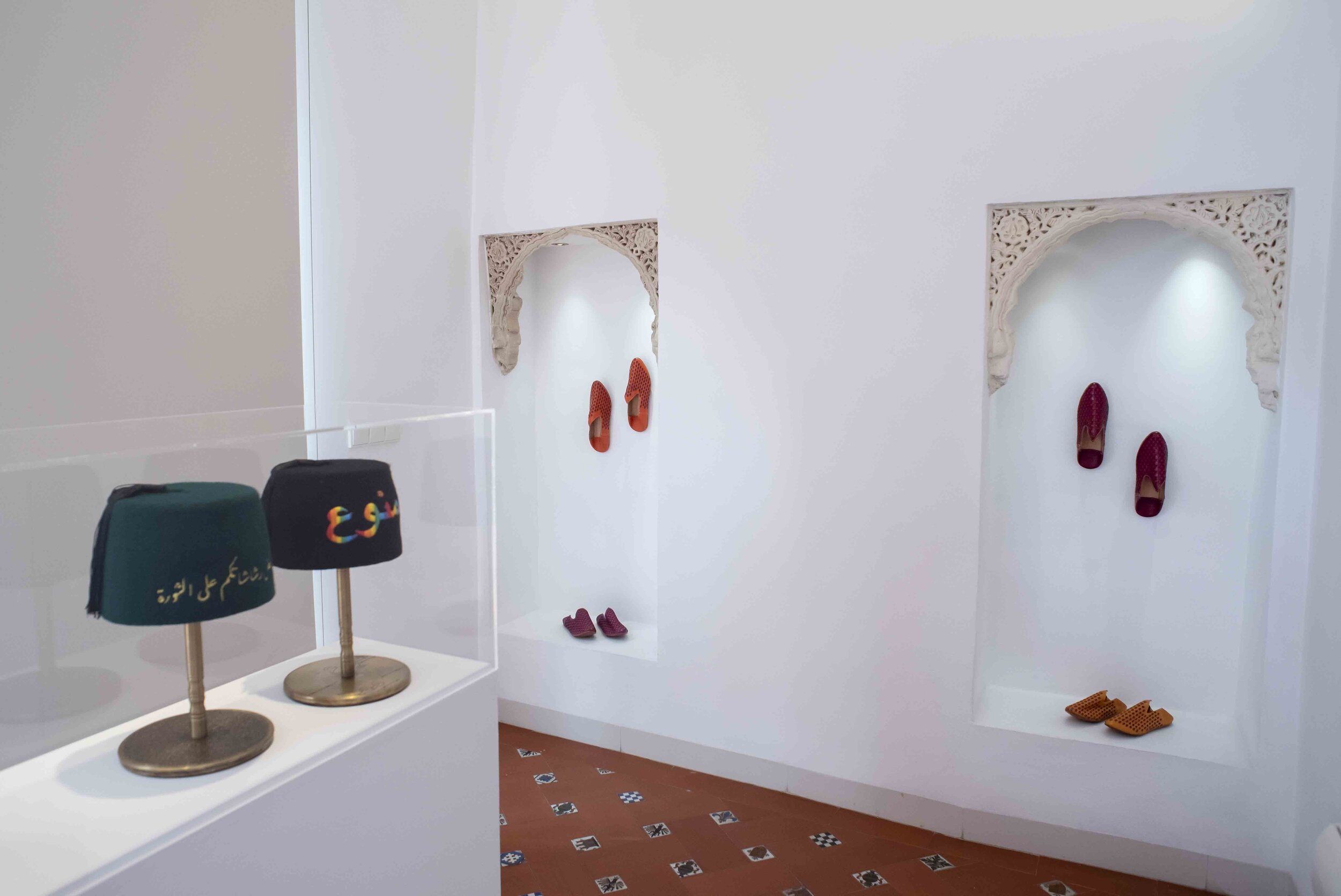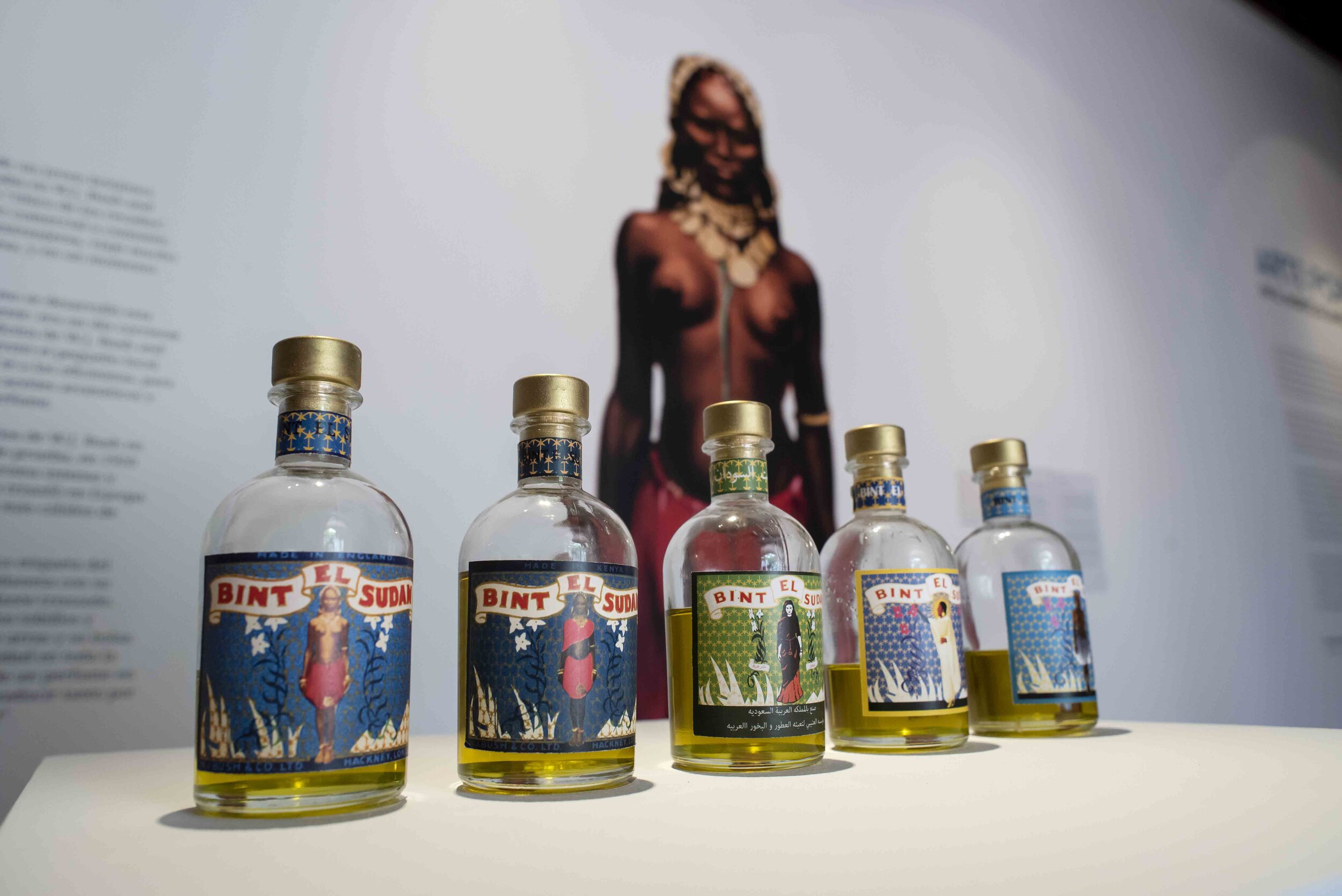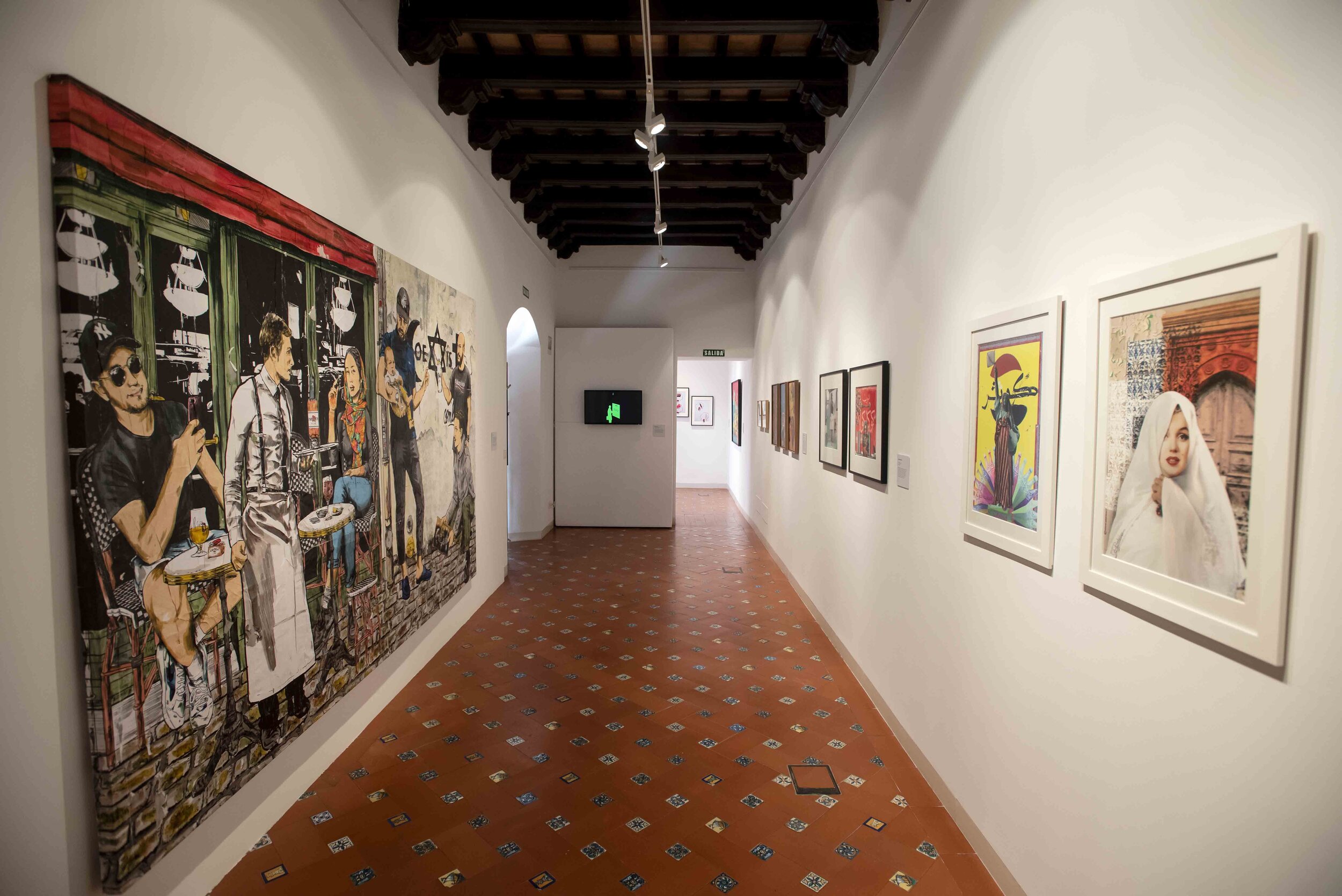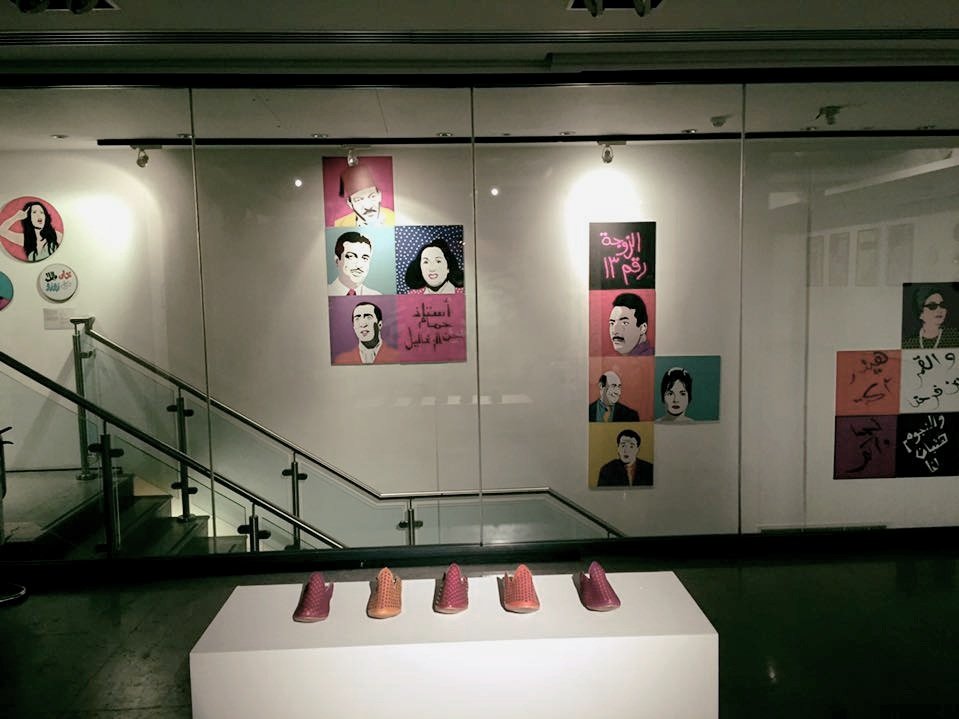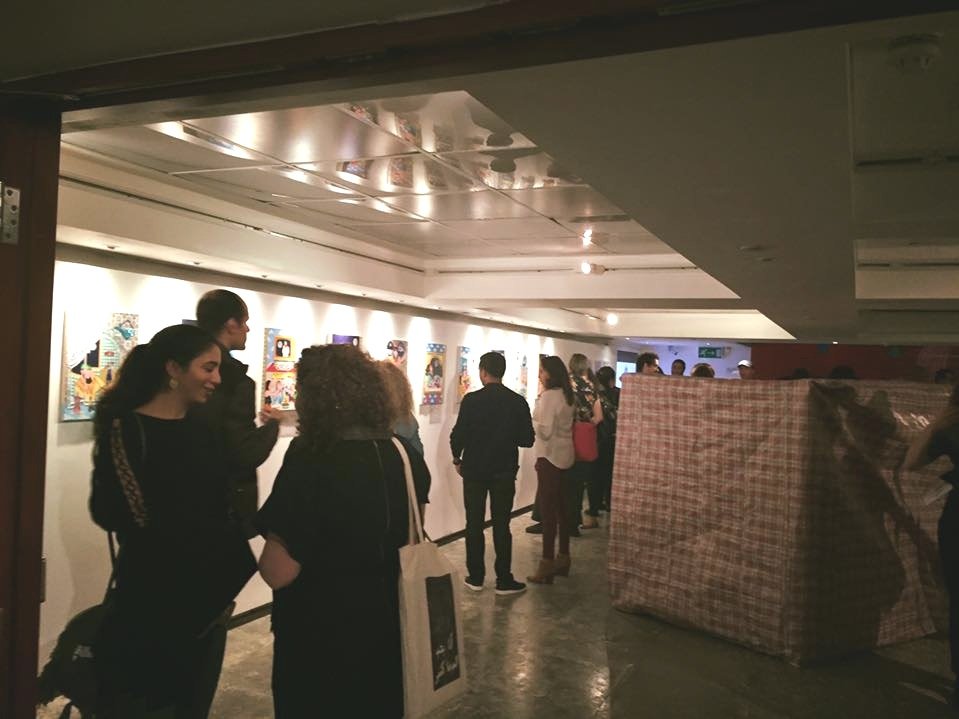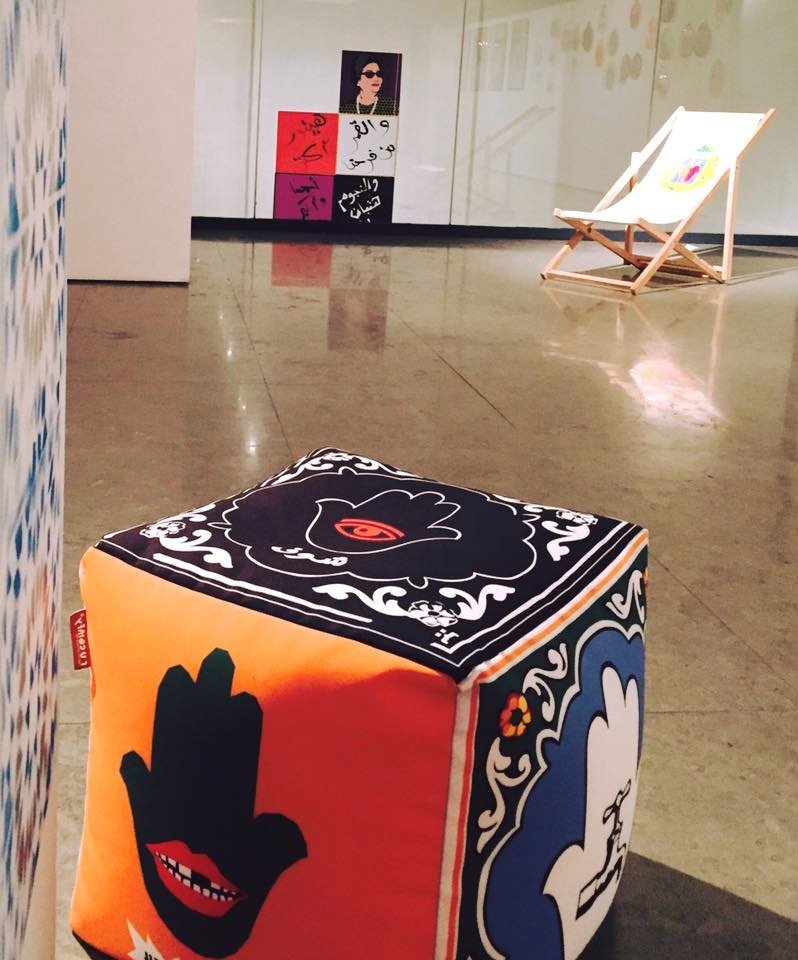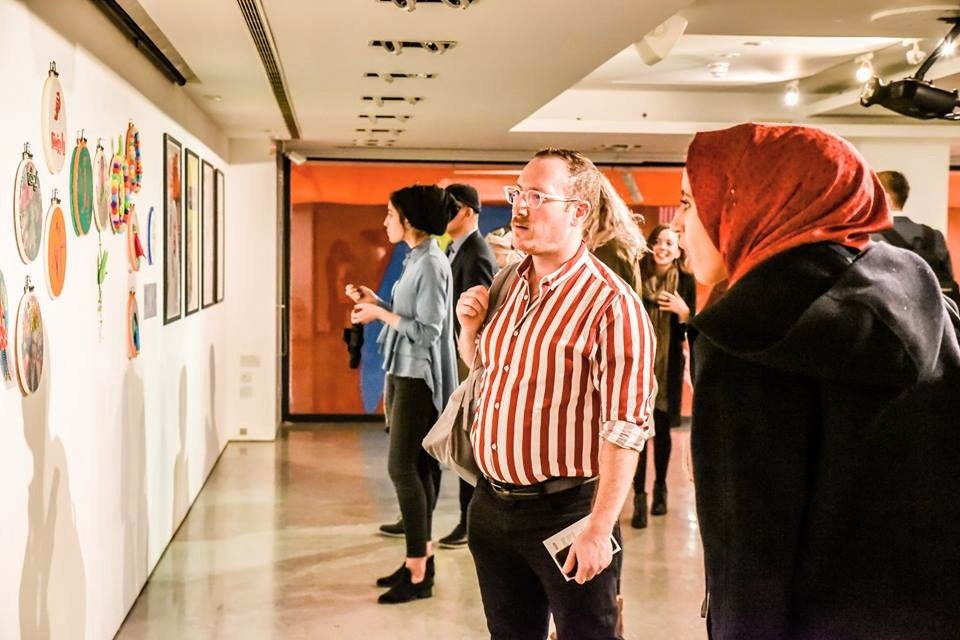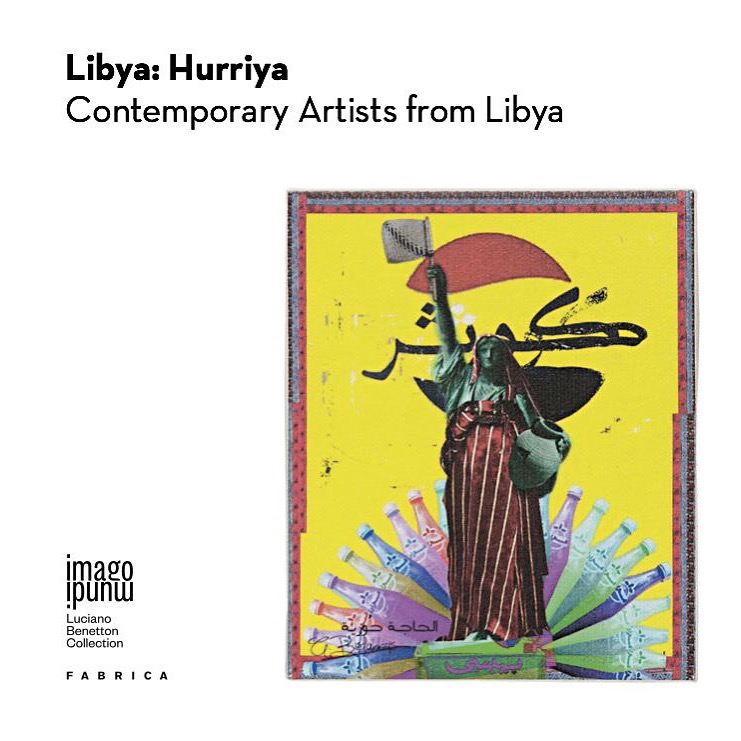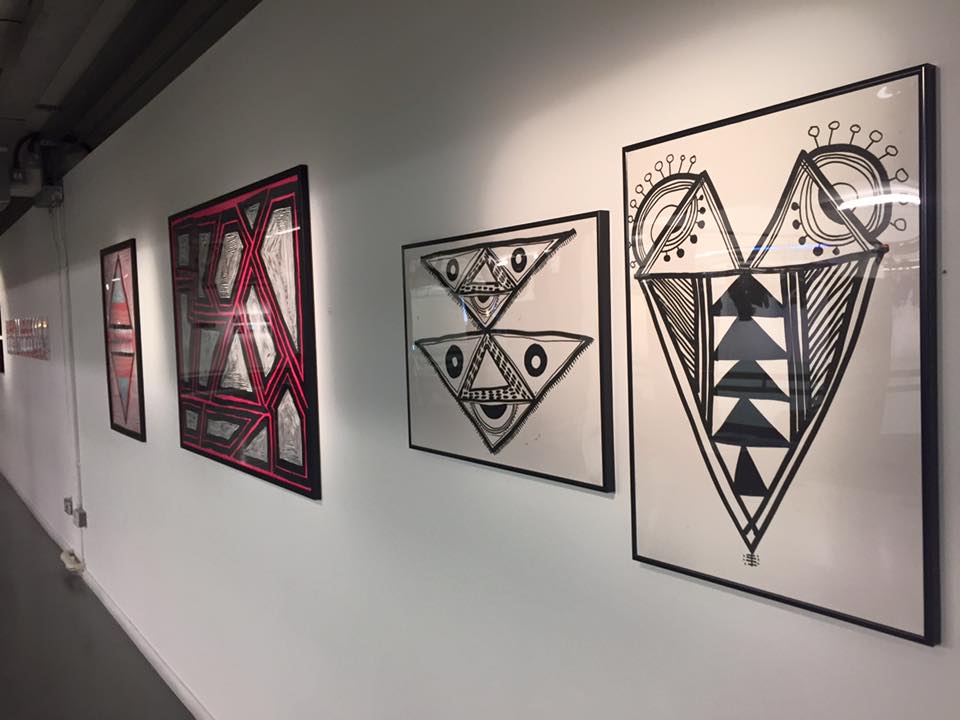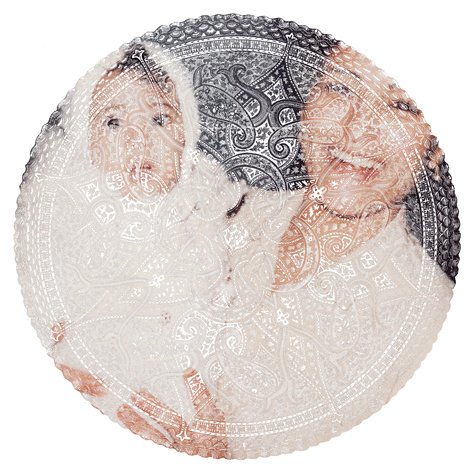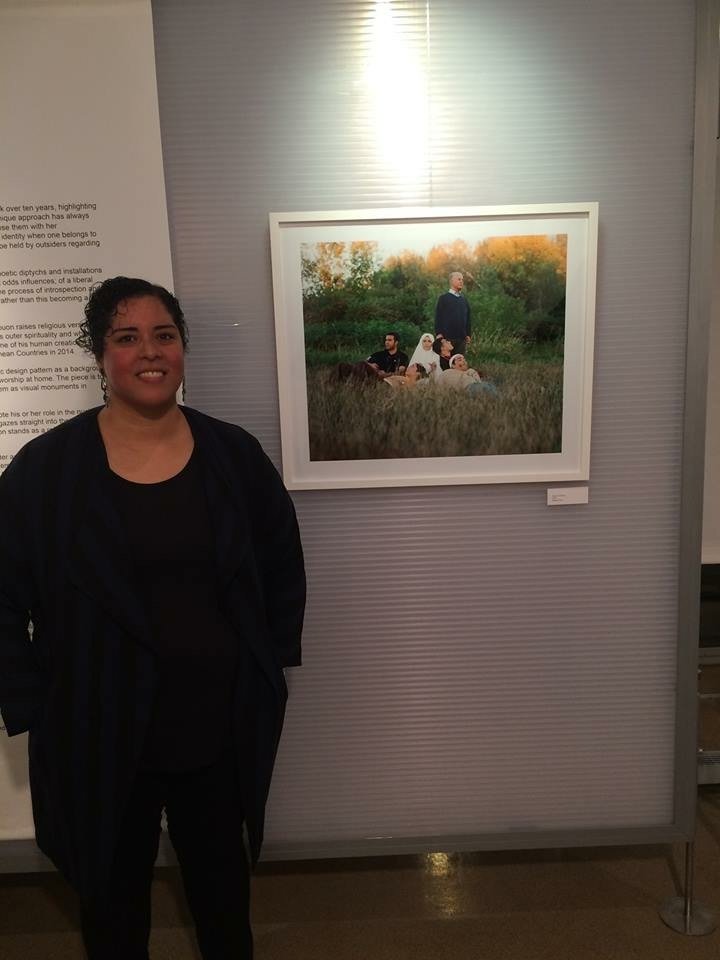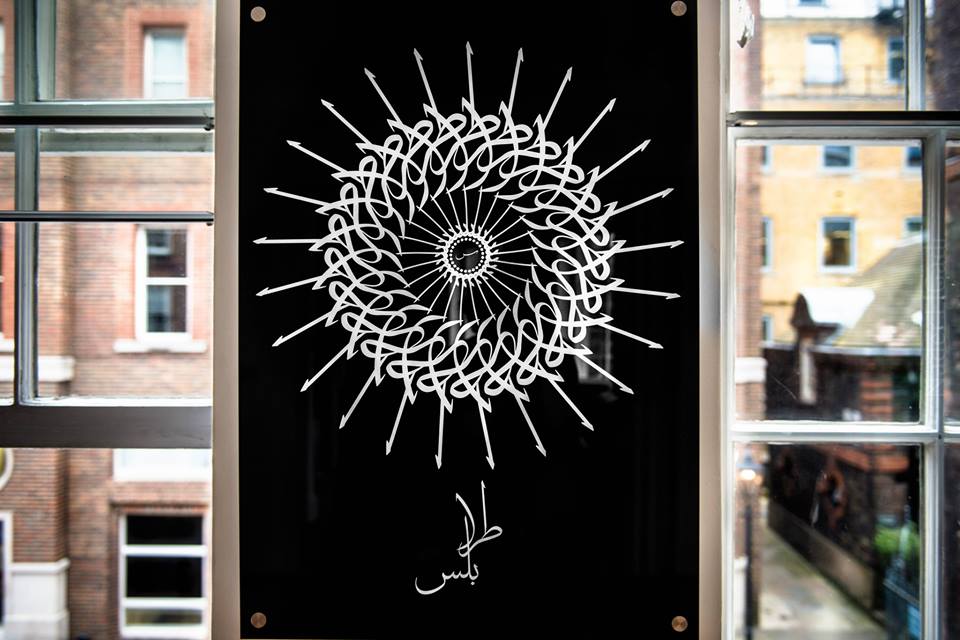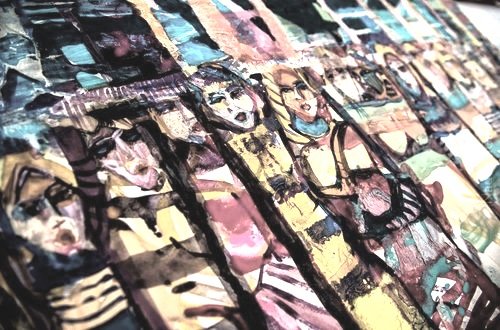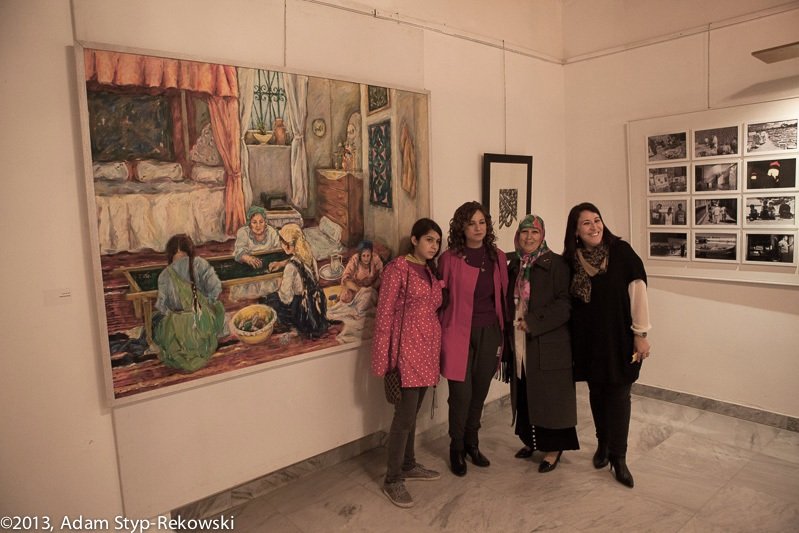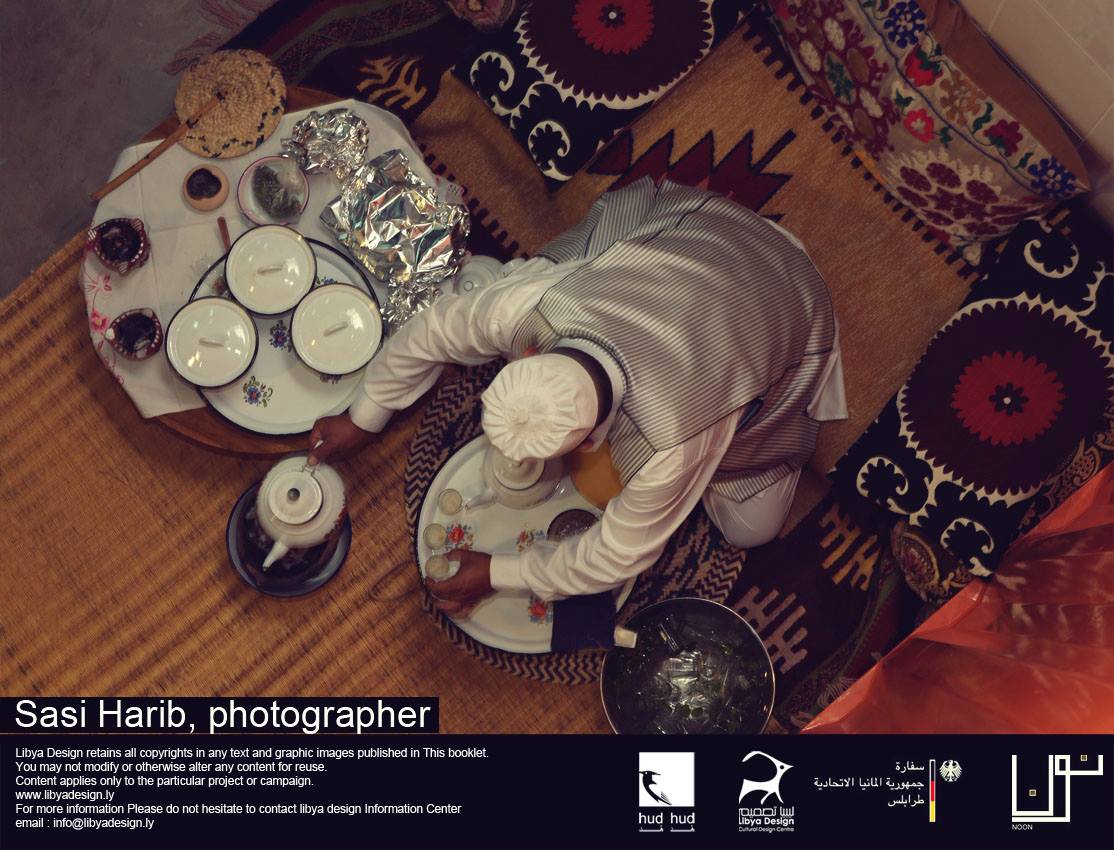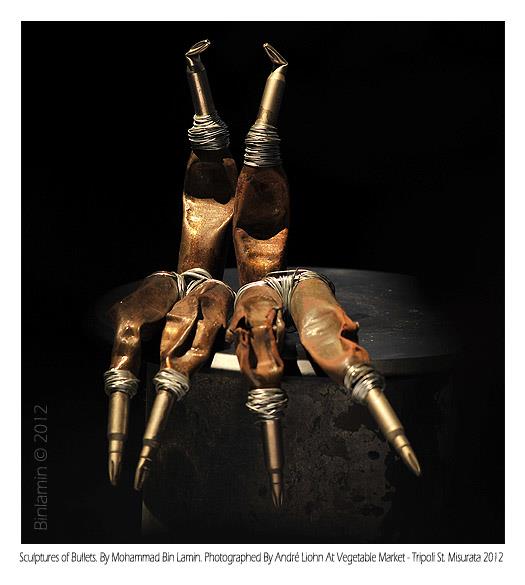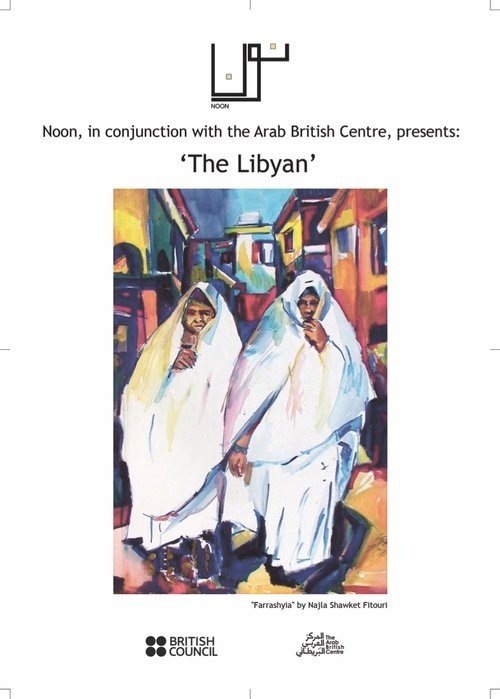Nedim Draws Writing : P21 Gallery, London - 17 May to 25 May 2024
Photo credit: Frederique Cifuentes
Nedim Draws Writing is a solo exhibition of Iraqi/Dutch multi-disciplinary artist Nedim Kufi, in which he embarks on a journey of imagination and exploration, delving into the essence of the Word itself. Through a meticulous process of fragmentation, Kufi's work breathes life into words and transforms them into tangible objects to reveal the hidden magic. These ethereal creations float in a weightless artificial universe, seemingly beyond our reach. Each element is crafted with precision, relying solely on the force of gravity and the delicate interplay between carefully chosen materials.
Language plays a vital role in Kufi's artistic pursuits, as he uncovers connections and brings out layering that is initially foreign but later familiar to the uninitiated eye. The displayed pieces showcase his innovative approach to language, as he skilfully moulds words into abstract and playful configurations to relay meaning, revealing overlaps and messages. The works represent an inventive yet expert manipulation of words and utilising forms with the emergence of a new graphic vocabulary.
Nedim perceives words as dynamic fluid entities, capable of being juxtaposed, reflected upon, nurtured, and cultivated; just like seeds that can be planted and later blossom, flourish, wilt, and ultimately regenerate, giving rise to infinite reinterpretations and a fusing of visual languages. With each work, the tension that arises between the words and picture, is harnessed to build a thesaurus of compositions and tangible items. The assortment encompasses a rich collection of Arabic words and letters, that he is thoroughly analysing, dissolving, and reimagining to bring out fresh and novel significance.
Curator Najlaa El-Ageli has noted: “Nedim Kufi's mastery of language is evident in his skillful use of diction to evoke vivid imagery. By intertwining words and visuals, he challenges the observer to question the meaning of language on both a general and specific level. Through his unique perspective and exploration, Nedim prompts thought-provoking realisations and draws the viewer into a world where words and images coexist harmoniously.
“In this exhibition, Nedim's artworks serve as a reflection of the current reality, blending mythical concepts, introspective musings, and linguistic creativity. The result is a visually captivating landscape characterised by disorder and curiosity. These pieces of art showcase the intricate interplay between Eastern and Western cultures, with Arabic letters, words, and text serving as a conduit for exploring the complexities of the language.”
Artist Biography
Nedim Kufi was born in Baghdad, Iraq in 1962. He obtained a BA in Fine Art (etching) from the Institute of Fine Arts, Baghdad in 1985. Following this, he pursued studies in sculpture at the Academy of Fine Arts, Baghdad from 1986 to 1990. Later on, he furthered his education by studying ceramics and graphic art at the School of Art, Utrecht from 1998 to 2002.
Since 1995, Kufi has been living and working in the Netherlands. His creative practice involves working with mixed media, including paper, flowers, earth, and ceramics; to establish a strong connection between various disciplines such as printing, etching, sculpture, and design. His art often incorporates grids, drawing inspiration from the Islamic tradition of repetition and patterning.
Through his work, Kufi explores and juxtaposes Middle Eastern and European cultures, using images and ideas that are rich in ambiguity and paradox. His methods also seem to challenge conventional notions of rationality, similarity, and contradiction on a global scale. He advocates for minimalism in art, utilising repetitive and overlapping structures to influence the viewer’s perception, and prompting spectators to reflect on their own identities, cognition, and social interactions.
Totalitarian Props : The Africa Centre, London - 24 June to 14 July 2023
Art curators Najlaa El-Ageli and Tewa Barnosa are proud to present the collective exhibition Totalitarian Props at The Africa Centre (London), in partnership with Shubbak Festival 2023. It will be accompanied by a parallel engagement programme led by filmmakers, artists and researchers from 24 June to 14 July, 2023.
Set within the context of the Pan-Africanism ideal and Pan-Arabism dream, this trans- disciplinary show explores and investigates how the state, government and utopian dictatorships develop modalites of population mass-control and utilise surveillance mechanisms that distort the common reality. By playing with political props, both real and imagined, a further link is made to the ongoing colonial conversation.
Blurring the lines between fact and fiction, Totalitarian Props also aims to share how the truth can be perverted, manipulated and disguised under authoritarian power structures. Taking Libya as one of the case studies, there is the pressing question of how severe rule over an extended period of time is psychologically processed post-trauma, especially when there has been little effort at formal reconciliation.
As some of the subject matter is deeply sensitive, the project acknowledges there will always be conflicting memories and accounts of the historical past. Still it hopes the audience and London viewers will ask questions and seek answers for themselves, in relation to the contemporary social orders of post-socialist and post-colonial nations.
The selected artists will share intimate work, bringing insight from their intense archival projects as well as academic research journeys, unleashing the imagination to represent what life feels like under totalitarian rule. Whilst some draw on real lived experience, others interrogate the broader socio-political picture, by bringing to light overlooked colonial histories and the formation of complex identities that are caught in between.
Barnosa has said: “As an antidote, this exhibition brings forward some of the real and honest accounts that would reflect, discuss, examine and correct some of the unfounded narratives. It puts forward what was never told and what was never allowed to be written and/or expressed in the first place.”
El-Ageli added: “I believe our history needs to be tackled from new and fresh perspectives to honour the memories still floating in living consciousness. The UK public will be presented with the interpretations of a cross-section of artists (from the MENA region and beyond) on how the political ideologies of Pan-Africanism, Pan-Arabism and tribalism played out in real life in North Africa, and how that brings us to the current volatile landscape.”
The artists, academics, filmmakers and others taking part in the show and engagement programme: Amado Alfadni, Jihan El-Tahri, Marwa Benhalim, Mai Al Shazly, Malak El Ghuel, Alessandra Ferrini, Tewa Barnosa, Afsoon, Hadia Gana, Born in Exile (Ibrahim Shebani), Marcella Mameli Badi, Alla Budabbus, Frederique Cifuentes, Khalid Shamis, Seraj Yousef, Jihan Kikhia and We Sell Realty Collective.
Project supported using public funding by the National Lottery through The Arts Council England
with The Africa Centre, London and in partnership with Shubbak Festival 2023
The Libyan Pantry : Old Spanish Prison, Old Medina, Tripoli - 27 Feb to 19 March 2023
The exhibition aimed to help recover forgotten stories and histories associated with Libyan consumer culture starting in the early 1960s when Libyan industries and companies started after Libya's independence and after the discovery of oil, and the timeline of the narrative continues to the 1970s,1980s up to late 1990s.
Memories are triggered when we look at some of the local products that we grew up with living in Libya. These are products that can make us feel proud, or nostalgic. They include many innocent items, be the fizzy Cola drink, A rug made in Libya, school exercise books, homemade candy, or a piece of cloth.
The exhibition is be a reflection on Libyan lifestyles influenced by consumer culture indicating values and the rationales that shaped and developed the society during the last 70 years.
The exhibition seeked to highlight the little-known history of graphic design and the influence of graphic design on Libyan society and the cultural impact it left in the Libyan collective memory. The material exhibited such as reproductions of company brands, industry logos, posters, and advertising graphics aimed to preserve and document the Libyan visual memory for future generations and as a means of preserving Libya's modern heritage since its independence.
Working with, Alhareth antique company, Libyan graphic designer Alla Budabbus, and artist Hadia Gana, we aimed to share with the Libyan public the journey of graphics and its impact on the social cultural Libyan mindset and how in return it makes the society unique, capturing behaviours and lifestyles of Libyans and how it was influenced by consumer culture.
“I wished to curate the exhibition as a continuation of retracing the Libyan collective memory as well as the social and cultural histories, so that a safe space is created to note and observe our modern heritage.
“Whether remembered positively or negatively, all these products became a big part of the Libyans’ experience and evoke deep associations. We can also at the same time look at the logos and the graphics in terms of their public marketing development; and how, although minimal, they all touched the Libyan state of mind and stayed embedded in our collective recall.”
Exhibition Launch clip
Amado Alfadni: Alternative Museum of The Sudan - Sulger Buel Gallery, London - 21 April to 30 June 2022
Amado Alfadni is an artist who was born in Cairo, Egypt in 1976 to Sudanese parents. His childhood environment was composed of both the Cairene street and the traditions of a Sudanese household. The relationship and the tension between these two different cultures strongly influenced his views, making him question the subject of identity with its related rhetoric, as well as the variables of nation and ethnicity in his work. Fearlessly through his art Amado engages with forgotten historical chapters that are difficult to digest, as he then references them with the current state of things. Based on his dedicated and passionate study with documentation, he delves into sore and sensitive passages of time that have been ignored, to make a credible case for those who thus far have not been heard, nor given a platform to speak of their anguish, pain, hurt and trauma, to understand the dotted lines left behind.
The ‘Alternative Museum of The Sudan’ is Amado’s first solo exhibition in London, that traces the findings of his five-year journey and research into the buried histories of the people of the Sudan who were badly affected by colonialism and other interruptive external forces. His multimedia works revive the local stories and reflect upon the fate of his Sudanese ancestors, revealing an incomprehensible exploitation of the African people, from the earliest times up to the present. The show also draws upon the artist’s interest in the notion of authenticity when an identity has come into contact with a colonial factor and or an aggressive power subjugation. He utilizes postcards, photographs, and oral archives to reveal some of the complex relationships that have ensued from the interplay between colonial dominance and how that has affected Black Africa as well as the intermingled histories of the people living in the unique geographical zone of where the Sudan meets Egypt and North Africa.
The ‘Alternative Museum of the Sudan’ project will serve as a repository of the material constructed in tribute to Amado’s subjects, such as the Bint El Sudan installation. Shedding light on the history of the popular Sudanese perfume that has been made and sold for decades and is still on the market, it draws parallels between the past and the present through the changing image of ‘a Sudanese Princess’ as we follow her visual transformation through the marketing labels over time, revealing how the female Sudanese figure has been manipulated through the masculine glare. Amado’s Kandaka or ‘Queen’ series also investigates the portrayal of the Sudanese woman, but this time through the Western-colonial gaze as evidenced by the old colonial postcards that are still in circulation today. This has recently opened huge academic and artistic discourse with the dilemma of how we should be treating these photographs, as we now question the conditions under which these women were made to model for the mainly European cameraman. On display also will be the ‘Askari Soldiers’ series, the ‘Ace of Spades’ and ‘Black Ivory’, in which Amado deconstructs the wider colonial narrative and its treatment of the Sudanese, as he disseminates the work by re-appropriating it to contextualize his own representation. In effect, he is offering the safe space to offer the dignity and acknowledgement of the men we now see, bringing up the feeling of respect in the viewer, and to ask questions and seek some answers.
In ‘Black Ivory’, for example, Amado investigates a recorded voice in the Sudanese Shilluk language of one of the thousands of kidnapped survivors who were forced to transport ivory from Sudan to Egypt. The recording tells of how he was later sold as a soldier by Britain to France to fight in colonial Mexico. Used as a ‘re-appropriated’ historical device, it restores the non-sequential energy of a lived historical memory, a fundamental component of meaning in representation. It also rescues the real narrative of those who have left behind no documents nor records, indicating that history can only ever be fragmentary and chopped up, made up of dissonance and that it is always provisional!
While in ‘Ace of Spades’, Amado opens archive material connected to the slave soldiers trade, using iconic photos which he has manipulated with motifs that raise and answer questions about the Sudan and other colonised African countries. By producing monoprints, he adds the ‘Tazeker Alhuryaa’ or ‘Freedom tickets’ that were given to those who were enslaved in Egypt to indicate the end of their slavery. As he states: “This is lifelong work digging into generations of hidden history buried under colonialist culture that persists to this day.”
Through his installations, Amado delves into the complexities of culture and identity in the aftermath of colonial presence, with a critical yet aesthetic eye that results in incredibly captivating artwork. In particular, he questions the British and Egyptian colonial stay and intervention in Sudan, beginning with the time of Queen Victoria, followed by King Farouk of Egypt. The artist has said that his work was essentially based on two elements: the Askari archived colonial photos and uniforms, and the patterned language of African textiles that first emerged in African culture through the use of the Dutch wax prints. These printed fabrics, at first based on Dutch-inspired designs, were quickly adapted by African women who turned them into local apparel. They in fact became a method of communication and self-expression, as they integrated colours, shapes, and visual elements with shared and intended meanings. Following that same tradition, the artist created his own Dutch prints and used them as a medium to convey his ideas.
Amado has stated: “My work discusses the relationship between the included and excluded and opens dialogue on issues of identity and politics. By working with forgotten historical events and current state policies, I raise questions of power dynamics between the individual and authority on the social and political level. It gives a voice to the marginalised minorities.”
Black Ivory clip - 2022
Combo: Darna (Our Home) - Sulger Buel Gallery - 25 November 2021 to 7 January 2022
Combo's North African cultural roots mix with a European consciousness, giving him an unusual perspective that is reflected in his artwork. With this particular installation, he tackles the social and political environment, taking the observer into a space of familiar and unfamiliar iconography that reference the duality of diasporic culture. With this work, also, he is exploring the issue of contemporary identity, that is driven by hyper consumerism and materialism.
Influenced by a fun pop art sense of humour with glimmers of cynicism, Combo acts as a public commentator who is rejoicing in his hybrid identity. In particular, he likes to manipulate globally recognised consumerist objects that we can all relate to and share; and, then, allowing them to encompass a critical interplay between Western and non-Western culture. He then playfully pushes forward the maghrebisation of the Western brands to at once critique Western superiority, yet presenting their new added value when they are adopted by the local Arab market.
The interactive installation works by recreating the intimate domestic space of a sitting room and how it may be fantasised by the Orientalist gaze, thus inviting the participant to discuss and investigate the evolution of the relationship between two complex cultural entities, using art as a space of a new narrative and perspective."
Fathi Hassan: Soul Taming - Sulger Buel Gallery, London
December 2020 - May 31 2021
Fathi Hassan is an artist, a poet, a dreamer; but, most of all, he is a dynamic creative set on taming his wild spirit and wandering soul through his art, meditations and poetry. Hassan’s visual work pulls the viewer firstly with its bold lines, then the floating texts, figures and symbols. Once that information and layer is absorbed, his pieces translate into a higher level of alchemical synthesis. His articulation unto the canvas is a deep form of poetry.
Essential to his work is the exploration of identity, as he constantly challenges, superimposes, writes and links events, past and present, to contemplate possible futures and potentialities. Hassan's diasporic adventure for almost four decades reflects the displacement and the journey between the different spaces, times, perspectives and memories. His creations also reveal a love and passion for classical music and Opera, wherein his lines translate into visual melodies of emotions. His attention to numbers, codes, letters and musical notes are also weaved back into his compositions reflecting a multidimensional orientation.
His tapestries can also be experienced as archival material containing delicate traces of his Nubian culture and its place in the Arab world, wherein the Arabic calligraphy intersects and blends into symbols. In some instances the letters and the words sharply cut through the Nubian-African heritage to suggest a struggle and the fight for domination and survival. This suspended state is a powerful reminder of not only the past, but also inherently of what is happening today politically, socially and culturally.
Ultimately Hassan' work is to record, store, archive and tame the memories of dreams, souls, life and desire. His quest to pin down a hybrid-cultural form of self and identity continues and is ever so resonant with what is happening now. His utilising of the desert and forest imagery is a tool to reflect upon the injustices and inequalities of the human condition and existential state of being. He also does a brilliant job in bringing forward a Sufi elemental landscape as well as responding to the more recent crisis relating to Covid-19, referring to the traumatic post-Arab Spring period, the rise of the conservative right in the West and the deconstruction of democracy.
WAVES : Art from North Africa , A virtual Exhibition
1 June - 31 August 2020 at Sulger Buel Gallery , London
Joined by their North African heritage, WAVES features an eclectic mix of art practitioners as they explore and respond to an environment wherein extremism, materialism, consumerism, manipulation and post-colonialism take on a particular form and impact on the local culture, as well as the making of waves out of these underlying social, political and economic currents.
Blending together fact and fiction, with past and present concerns, the creative works comment and playfully distort an inherently complex reality; thus, making new extensions and offering an authentic experience in which the artists reside. Whilst each has different skills and talent, what is pertinent to the North African identity within the universal context is hereby revealed with a great cross section of origins coming from Egypt, Sudan, Tunisia and Morocco.
Najlaa El-Ageli: “I am excited and honoured to be curating this exhibition at Sulger-Buel, focusing on the current waves crashing onto the North African arts scene. In terms of the appreciation of visual art, this part of the African continent is sometimes forgotten or sidelined, but as a place it has always been a magnet for every kind of civilisation and that has left deep imprints onto its collective cultural, social and political psyche.
“This exhibition seeks to highlight the diversity of thought and technique that is employed by the artists, from Amado Alfadni's commentary on the repercussions of post-colonialism on the region, to Soad Abdul-Rasouls's queries into the female place within society, to Combo's diasporic discourse on the North African identity in Europe.
“We also have Ilyes Messaoudi’s magic wand that revives the olden tales of Scheherazade within the modern Tunisian setting, to lastly Hany Rashed’s satirical windows conveying popular Egyptian street and domestic life. All in all I want to share the beautiful North African vibes and the energy that is presently undergoing major tidal change and transformation.
Retracing A Disappearing Landscape - Casa Arabe , Madrid, October - December 2018 , Cordoba 23 Oct 2019 - 8 Jan 2020
Pop Art From North Africa , Casa Arabe, Madrid , 3 Oct - 1 Dec 2019
Casa Arabe, Cordoba, 8 July - 2 Oct - 2020
Paris Outsider Art Fair
18 October - 22 Ocober 2018 / Atlier Richelieu / Paris
The exhibition is of a gathering of artworks within the context of post-Revolutionary Syria, Egypt and Tunisia; where the future of the socio-political terrain still is uncertain. (In the Meantime) puts on discourse the shifting cultural, and social agendas concurrently taking place. The artworks selected aims to hold a conversation as to the disconcerting past, and what the future might hold. Each artists on his or her own right confronts important issues such as sexual harassment, gender, cross cultural identities, migration, corruption, and the subtle quest for Freedom in their work.
The collection attempts to investigate the scope of social and cultural disintegration of urban lives, the surreal chaos and the waiting game for the unknown. It will take the audience on a voyage through urban landscapes, exploring the human condition and indicating the tortuous clash between tradition and modernity of the concurrent state of the region where the artists become the public commentators on the most discussed issues within their respective societies.
Artists : Rasha Amin (Egypt) , Ilyes Messaoudi (Tunisia) , Dima Nachwai (Syria), and Qarm Qart (Italy/Egypt)
RETRACING A DISAPPEARING LANDSCAPE
30 March - 15 May 2018 / P21 Gallery/ London
Founder of Noon Arts Projects, Najlaa El-Ageli, is proud to present her latest curatorial project, ‘Retracing A Disappearing Landscape’, in partnership with the P21 Gallery. An interdisciplinary show, it will bring visual artworks, installations, films and photography – as well as a wide parallel programme of events - involving the participation of over25 contemporary artists and professionals connected with Libya.
The first of its kind internationally, this six-week exhibition will explore people's direct experience of and fascination with memory and personal history relating to modern day Libya. It will consider also the contested question of whether or not there is a collective national identity. With the mixed input of the artists -including film material provided by British Council Libya - this will be an eye-opener for special guests and the general British public.
Confirmed artists and professionals: Najat Abeed, Mohammed Abumies, Huda Abuzeid, Mohamed Al Kharrubi, Takwa Barnosa, Mohamed Ben Khalifa, Najwa Benshatwan, Alla Budabbus, Malak Elghwel, Elham Ferjani, Yousef Fetis, Hadia Gana, Ghazi Gheblawi, Reem Gibriel, Jihan Kikhia, Marcella Mameli-Badi, Guy Martin, Arwa Massaoudi, Khaled Mattawa, Tawfik Naas, Laila Sharif, Najla Shawket Fitouri, Barbara Spadaro, Adam Styp-Rekowski.
The visual elements start with the archetypal memories associated with the traditional Libyan family album, showing images and scenes from personal archives that go as far back as the early 1900s. Whilst the second segment will feature especially commissioned installations that aim to stand as temporary repositories and witnesses to the country’s history, as well as constructing new narratives. They will be for both viewing and audience interaction.
Viewers will notice that the capital city of Tripoli is a recurring monumental backdrop found in the artworks and installations, wherein the city’s past, its signposts and architecture become intermingled with the artists’ stories and their attempt to capture and retrace the city’s disappearing and ever-changing landscape.
The raw history of the entirety of Libya will also come into view with reflections on its many uncomfortable episodes, including: the colonial period and existence of Italian concentration camps, the current migrant crisis, the shifting urban landscapes, the suffering under dictatorship for 42 years and the turbulent post-revolutionary period.
Looking at the known and unknown memories of Libya as a homeland through the work of its citizens – both at home and abroad - the country is revealed to be a powerful force in their lives, as it is still carried in their hearts, thoughts and collective psyche. By sharing their experiences, it is hoped to develop an intelligent and meaningful discourse on what Libya represents for its people and the hopes that exist for its future.
Running in parallel to the visual exhibition will be an extensive programme of discussions and presentations that will be held at the P21 Gallery. These will host Libyan and non-Libyan artists, academics, writers, poets and researchers who will delve deeper into some of the pertinent topics regarding Libya's artistic, intellectual, cultural and historical landscapes.
‘Retracing A Disappearing Landscape’ is generously supported and funded by the Arab Fund for Arts and Culture (AFAC), DARF Publishers and private individuals.
POP ART FROM NORTH AFRICA
22nd September - 4 November 2017 / P21 Gallery / London
Curators Najlaa El-Ageli and Toufik Douib are proud to present the ‘Pop Art from North Africa’ collective exhibition, in partnership with the P21 Gallery and the Arab British Centre, and supported by the AMAL: A Said Foundation Project and Darf Publishers.
The artists: Mouad Aboulhana (Morocco), Alla Abudabbus (Libya), Rasha Amin (Egypt), Dhafer Ben Khalifa (Tunisia), Amel Benaoudia (Algeria), Walid Bouchouchi (Algeria), El3ou (Algeria), Malak Elghuel (Libya), Sarah Basma Harnafi (Morocco), Sarroura Libre (Tunisia), Meryem Meg (Algeria-Bulgaria), Ilyes Messaoudi (Tunisia), El-Moustach (Algeria), Qarm Qart (Italy-Egypt) and Sofiane Si Merabet (Algeria).
The show will put together for the first time under the P21 Gallery roof, the exciting artworks of fifteen creative individuals from North Africa who are all inspired by the Pop Art movement. Every country in the region will be represented, including artists from: Morocco, Algeria, Tunisia, Egypt and Libya, as well as their diasporas living in Europe.
In the style of one of the 20th century’s most influential movements that was spearheaded by Eduardo Paolozzi and Richard Hamilton in 1950s Britain, the combined works tackle the social, political and cultural environments unique to North Africa.
Through paintings, digitally manipulated images, animation, music and street art, the show will take the audience on a voyage through urban landscapes, exploring the human condition and indicating the tortuous clash between tradition and modernity, in homage to the pioneers of the Western pop art, such as Keith Haring, Andy Warhol and Roy Lichtenstein.
The engaging display will also be reflecting on how the artists become public commentators in their society in the quest to explore a local identity within the context of a globalised consumerist world. It will encompass the critical inter- play between Western exported products and how they are consumed in North Africa; and, especially, in the use of the international icons that come to hold new value and meaning when manifested in a different environment.
Addressing the theme of the ‘Maghrebisation’ of Western commercial brands, for example, there is an implicit critique of the supposed ‘American-Western’ superiority. One sees however that the artists also utilise the public and common symbols, images and narratives that are more specific to the North African region and considering the powerful role that they play in the collective Maghreb psyche.
El-Ageli: “This show will bring forth to its audience the pure and authentic North African consciousness through the pop art form. By its nature direct and accessible, the group exhibition reveals the innate sense of humour that is blended with a subtle touch of cynicism and delivered with light-hearted connotations. It offers a complex, intelligent and meaningful picture of themes that are dear to the North African people and what occupies their minds and awareness.”
Douib: “In the west, pop culture has quickly become a phenomenon, beginning with re-appropriation and reinvention and then evolving into an industry for dreams and evasion. Pop art is constantly evolving in how it communicates with the masses and engages with minorities. Similarly, pop art in North Africa helps creatives to look at the relationship between hypermodernity and tradition.
“From tale characters to showbiz celebrities or blockbuster superheroes to historical gurus, what is extraordinary in North African pop art is its ability to intertwine eclectic ingredients of culture, confirming both sense of belonging to common roots and openness to a universal movement. At a time of geopolitical challenges within and beyond the region, it is very exciting to showcase a unique representation of a united Maghreb.”
Providing a fresh new alternative perspective on North Africa and its visual culture for the British public, there will be also a parallel program of events taking place at the P21 Gallery. Soon to be announced, this will include panel discussions with some of the artists and the curators.
JEWELLED TALES OF LIBYA
19 -27 January 2017 / Arab British Centre / London
In collaboration with the Arab British Centre and co-curated with Hala Ghellali, the ‘Jewelled Tales of Libya’ was a rare exhibition that explored the diversity and historical identity of a country through its tradition of fine silver jewellery. By showcasing the rich cultural heritage to the wider public, it aimed to tell the stories behind the adornments and the symbols that feature heavily throughout the geographical expanse that we know as Libya.
Alongside the display of 45 authentic dating from the 1920s to the 1960s that comprised of chokers, belts, headpieces, bangles, silver slippers and other items, a parallel aspect was the extraordinary vintage photography of Libyan women dressed in their finery that came from a historically valuable private collection.
Dating back to the early decades of the 20th Century, many of the images were taken by the Italian cameramen who had established studios in Libya during the European colonisation, from Aula, Nascia, Rimoldi and others who contributed to the Orientalist strand of photography. In contrast to these, there was also on display more recent photographs taken by the talented Libyan photographer Sassi Harib, whose work captures the essence of Libya’s Southern women.
Viewing Libya's silver jewellery through these three angles brought to light the reality of Libya's colourful past and the many influences that have impacted on it. From the ancient Greek and Roman civilisations to the input of the African, Amazigh, Bedouin, Moorish, Jewish, Ottoman and Arab peoples, the jewellery itself innocently revealed the country's difficult journey over the millennia but without making any negative judgment on it and without hiding any of its uncomfortable truths.
IMAGO MUNDI : Libya Catalogue
18 February - 10th March 2017 / Zisa Zona Arti Contemporanee / Palermo, Sicily
But for the size of the canvas for submission, the international ‘Imago Mundi’ project offers a truly democratic platform for all artists across the world to take part in. With the aim of curating an Arts catalogue for each country to be found on the global map, the Benetton Foundation formally invited Noon Arts to curate the Libya edition.
A huge logistical challenge, it took Najlaa eight months to identify, locate and convince 140 Libyan artists to participate. The issue of delivering and returning the 10x12cm canvases in a country with little to zero postal services was a difficult task, but one worth the effort. The catalogue was successfully compiled and published in 2016 and will be touring the world for years to come as well as for the original canvases to be on permanent display in Italy. Most recently, it has been shown at the Biennale Arcipelago Mediterraneo (BAM) in Palermo.
Belonging to a country that is so vast in its geography and with a complex social and ethnic make-up, the work of the local artists reflected on Libya’s multi-layered landscape and its diverse background. The catalogue revealed some very real hidden treasures with bold, courageous and skilful art that is testimony to a thriving Libyan arts movement.
Curating the ‘Imago Mundi’ was definitely a journey of discovery that has resulted in a colourful visual representation of the artists’ collective dreams, worries and aspirations both in print and on canvas. This catalogue will provide a significant reference point for future generations as a documentary archive encapsulating Libya’s artists during this special moment in time, when the uncertainty of what is Libya could have prevented it from happening.
The project involved many people at different stages who are worthy of mention and credit: Emad Pachagha from ‘The Art House’ in Tripoli and Abdelgader Bader in Benghazi, whose support and dedication led to the location of 110 artists inside the country, other than the 30 artists who lived abroad.
In terms of research, feedback and editing, credit to: Nahla Al-Ageli, Hadia Gana and Hala Gellali. Special thanks also to: Ali Mustafa Ramada, Muftah Abudjaja, Farida Hajaji, Nadine Nasaret, Siraj Dugdug, Nouman El-Ageli, Eman Fezzani and Faisel Almeehoob. Last but not least, credit is due to all the artists who took part and the Benetton Foundation that entrusted Noon Arts to undertake the Libya project.
TEXTURAL THREADS
3-19 March, 2016 / Rich Mix / London
Appointed by the London-based Arts Canteen, Najlaa curated this visual arts project as part of the ‘Arab Women Now Festival’ (AWAN) 2016. Held at the Rich Mix venue in East London, ‘Textural Threads' brought the work of five female Arab artists whose work opened up an important dialogue on both the universal as well the local issues of gender, identity, culture and the human body.
The input of Takwa Barnosa (Libya), Nasreen Shaikh Jamal Al-Lail (Saudi Arabia), Dima Nashwai (Syria), Meryem Meg (Algeria-Bulgaria) and Hania Zaazoua (Algeria) brought a beautiful touch to the multifaceted exchange on contemporary Arab female subjectivities. By utilising different textures and methods, they all approached some of the most difficult topics impacting on the Middle East and North Africa (MENA) region today as well as highlighting what seems to be pertinent to the Arab.
From Nashawi’s elegant illustrations that told of what it means to be a Syrian living in London, to the young Barnosa’s use of bold brush strokes of Arabic script on newsworthy photography, to the captivating digital prints on soft silk material by Zaazoua, these women reclaimed the imaginative terrain and showed how art can become the cathartic measure to keep one sane amidst the crazy dramas playing outside on the streets of a blighted zone, as well as by looking psychologically inwards for answers.
Collectively striving to advance a peace, hope and love agenda, the exhibition was a celebration of womanhood itself and also how to defy the simple categorisations of what it means to be a creative from MENA. Organised by Arts Canteen, AWAN is an annual event held in London every March on the occasion of International Women’s Day. It focuses on Arab female artists to help increase the visibility of their work and talent by exposing it to newer audiences every year.
BIRTHMARK THEORY
20 October – 14 November 2015 / London Print Studio / London
Partnering with the ‘Nour Festival of Arts’ 2015, Najlaa curated the artworks of Arwa Abouon at the London Print Studio. This exhibition ran alongside the wider festival that annually celebrates contemporary Middle Eastern and North African arts and culture and which takes place in venues across the Royal Borough of Kensington and Chelsea.
‘Birthmark Theory’ was a retrospective show of the artist’s work going back over ten years and displaying some of her most iconic and award-winning pieces. Abouon’s approach is to use the motifs and symbols from her Islamic background and to juxtapose them with her Western-Canadian credentials. Reflecting on what defines an identity when one belongs to two different cultures, she subverts any prejudices that may be held by others.
Courageously employing herself and her family members as art models, her poetic diptychs and installations express and illustrate the possibilities of reconciling what might seem to be at odds influences - of a liberal versus conservative environment and also on being a woman. In the process of introspection, she finds and creates a happy medium that celebrates the colourful mix rather than it becoming a source of struggle or conflict.
‘Birthmark Theory’ featured the ‘Mirror Mirror / Allah Allah’ diptych that won the second prize at the 26th Annual Alexandra Biennale for Mediterranean Countries in 2014a and other works including the ‘I’m Sorry / I Forgive You’ diptych, the ‘Abouon Family’ picture, the ‘Celestial Sphere’, the ‘Generation Series’ and the ‘Pear Shape’.
At the time of presenting her work, Abouon gave a statement: “My work results from the dynamic interactions between personal reflections on human nature, an attempt to meet and see the world as it is, and the multiple perspectives of my own gaze. The attempts to visually translate these specific configurations of subject, time, and place are usually photographic, but also sometimes integrate video, design or additional installations.
“I am also investigating mechanisms at play when learning and acquiring knowledge, and the different shapes that this knowledge takes on as it is transferred from one generation to another. Balancing playful humour, re-appropriation and respectful homage, I hope my work is always visually intricate in the subtleties within its voices.”
THE MELTING POTS
14 - 23 July 2015 / Arab British Centre, London
‘The Melting Pots’ exhibition brought a mix of artwork that considered the open concept of a city in relation to both Tripoli and Benghazi, Libya. It presented the subjective interpretations of the artists as each depicted his or her relationship with either one of these two ancient metropolises. Altogether there were seven participants, six from Libya and one from Poland.
Displaying their paintings, photography and questioning installation art, every piece was a form of creative contemplation upon the history, the present and the future of these sister capitals, as well as the realisation that neither one can be easily defined or pinned down. With a history spanning thousands of years, both of these cities have been conquered, destroyed and have had to be rebuilt several times.
From the ancient Phoenicians and the Carthaginian to the Berber, the Byzantines, the Romans, the Arabs, the Spaniards, the Greeks, the Turks, the Knights of Malta and modern Italy, they have all influenced the character, landscape and architecture of Tripoli and Benghazi, with the many layers of diverse humanity having inscribed their messages on the walls and leaving their marks that are still visible.
The highlights of the exhibition were: Najla Shawket Fitouri’s colourful paintings that depicted Tripoli and Benghazi in the female form, Hasan Dhaimish’s ‘Sketches of Libya’ series of digitally manipulated images showing the Libyan cities during the Italian Occupation and the Golden Era of the 1950s and 1960s, Hadia Gana’s ‘Tripoli Pebbles’ installation, Nawal Gebreel’s ‘Spiral Fabrics’ sculptures, Muftah Abudajaja’s digital calligraphic images, Ibrahim Tawati’s photography of Benghazi and Adam Styp-Rekowski’s photography and prose.
A LIBYAN LAMMA
9 January - 16 February 2014 / St James Cavalier / Valletta, Malta
‘A Libyan Lamma' exhibited the work of six contemporary Libyan artists and gave them the rare opportunity to show their pieces to the Maltese public for the very first time at the venue of St James Cavalier Centre for Creativity in Valletta. It was kindly sponsored and supported by Medavia Airlines and Mediterranean Investment Holdings.
'Lamma' - which means a social gathering in the local Arabic dialect – brought paintings, sculptures, installation art and photography within the context of post-Revolutionary Libya; where on the one hand there was the sense of a wider scope for artistic freedom of expression, but where also the future of the socio-political terrain was and still is uncertain.
Some of the highlights were Mohammad Bin Lamin's sculptures that were made from recycled war materials like metal bullets, Matug Aborawai's incredible paintings and sketches of drowning immigrants on their way to Europe, Hadia Gana's ‘Zarda’ installation piece and Naziha Arebi's photographs that offered an unusual glimpse into the private celebrations of Libyan women. The other two artists were Yousef Fetis and Arwa Abouon.
Commenting on the exhibition at its opening, Najlaa said: "There has always been a very special trade relationship between Malta and Libya and Noon's aim is to open a dialogue between the Maltese public and the Libyan artists to help create richer cross-cultural understanding and the appreciation of each other”
NAJLA SHAWKAT FITOURI
6 - 20 January 2014 / Corinthia, St Julian, Malta
Held at the Corinthia Hotel in St Julian, Malta this was a solo exhibition for the Libyan artist Najla Shawket Fitouri. Born in Libya in 1968, she is a graduate from the Faculty of Arts at the University of Tripoli and has made a name for herself in the emerging Libyan art scene; and, especially, in her advancing and making heard the female voice.
Fitouri's paintings focus mainly on the lives of her home country’s women with her visually dramatic interpretations of their lifestyle and the use of powerful imagery. Her themes touch upon the constantly evolving Libyan female identity by reflecting on both the personal and collective worries and experience. She also addresses their emotional pain alongside the happier moments lived during this time of a country and a people in transition.
A strong and vibrant paint palette with reds and blues graces her work and she is constantly pushing the boundaries, by testing with different forms and art techniques as well as inventing newer ones. Fitouri has a once-seen recognisable style that speaks volumes about her individual story and that of all other Libyan women.
At the time of presenting her work, she gave a statement: “I try to open a dialogue with myself through colour, as colour can neither be monitored nor controlled politically. Colour to me is the creative language that is innocent but that can also question the spirit and the political realm.
"The challenge before the Revolution was how to use and manipulate colour as a way to translate my inhibitions and insights. Now post-Revolution, the fight is for my freedom away from the political… I can be more exploratory and fearless through my paintings and it is an adventure that requires a struggle to meet the ultimate goal and to reach a wider audience.”
THE MELTING POT
2 - 5 December 2013 /Dar El Feghie Hassan / Tripoli, Libya
Sponsored and supported by the German Embassy in Tripoli, Libya this exhibition considered the concept of a city in the case of Tripoli. The artwork reflected the different interpretations of the artists as they conveyed their feelings, thoughts and ideas about the capital town and representing parts of its past, present and future.
Oea as the Phoenicians had named her, has been destroyed many times and conquered; from the Phoenicians to the Berber, the Byzantines, the Romans, the Arabs, the Spaniards, the Turks, the Knights of Malta and modern Italy. It has gone through many difficult phases and has had to be defiant and resilient, as well as needing to merge aspects of the ancient with the new, the sane with the insane and finding itself unwittingly tired and debilitated.
The artists beautifully captured Tripoli’s many paradoxes and concluded that it is still a work in progress. With the paintings, photography, etchings, lino cut printing and installation, this ancient crossroad continues to proudly declare its long and colourful history and is determined that it will remain a melting pot of culture. Bearing witness to all it has had to survive, including a cruel oppression that lasted over four decades, it shall continue to simmer for years and years to come.
The artists who took part in ‘The Melting Pot’ exhibition were: Najla Shawkat, Huda Ben Musa, Hadia Gana, Bashir Hamouda, Mohammed Ben Barka, Mohammed Kharoubi, Mustafa Abudajaja and Adam Styp Rekowski.
HADERZA MENSIA
15 - 24 June 2013 / Doshma, Tripoli, Libya
‘Haderza Mensia’ translates as the forgotten chatter in the local Arabic dialect. It was Noon Arts’ second major exhibition sponsored by the German Embassy in Tripoli, Libya and Hud Hud Ltd and held at the Doshma venue. Its aim was to showcase the work of twelve artists as they reflected on the new status of post-Revolutionary Libya, with the pieces holding a conversation as to the disconcerting past and what the future might hold.
The collection was made up of some very powerful artworks through the mediums of photography, paintings, sculptures and film. It truly captured that moment in time when the Libyans were beginning to explore the hidden side of human nature and revealing their worries and concerns for a nation just liberated from dictatorship but still teetering on an insecure base and lacking a foundation.
The particular choice of subjects and the use of symbols and clever ironies conveyed many of the personal and collective topics that were on the mind of all Libyans. For many of them, the real Libya felt as though it had been forgotten, but with art being a best means of influence, the artists addressed the country’s precarious status in a visual way and highlighted what they felt was being ignored.
Some of the issues grappled with, for example, were the predicament of Libya’s vulnerable women and its frustrated youth as well as the plight of innocent children and the elderly. The exhibition was thus a heartfelt invitation to the public to join in the chatter with the artists and offer everyone a safe space for open and honest discussion.
The artists involved in ‘Haderza Mensia’ were: Yousef Fetis, Najla Shawket Fitouril, Faten Babaa, Hadia Gana, Mohammad Bin Lamin, Boudur Jazeri, Mariam Hanedi, Sassi Hareb, Muftah Abudajaja, Huda Abuzaid, Khuloud Alzwei and Naziha Arebi.
THE LIBYAN
22 - 30 November 2012 / The Arab British Centre / London
Supported by the British Council, ‘The Libyan’ was the first exhibition curated by Noon Arts. It brought together for the very first time in London the wonderful work of eight living Libyan artists. Both male and female, from the ages of 24 to 67, their produced work included paintings, short film, photography, sculpture and installation art.
The mixed show offered a sample collection of the great emerging art that started to come out of Libya circa 2011 and that drew upon the Libyan’s preoccupations; from the portrayal of the day-to-day local lifestyle and culture, to Libyan women's beauty, to touching upon the political oppression under Gaddafi as well as conveying some of the promises of a recent Revolution.
Extremely colourful with an exotic air in terms of the response from the foreign gaze, the works truly challenged any negative preconceptions that others may have had in relation to the potential of the art coming out from what was then a newly liberated and emerging free democracy. The Libyan artists were finally able to explore, express and expose without fear of censure or reprisals their hidden thoughts and dreams.
The artists who took part in ‘The Libyan’ were: Yousef Fetis, Mohammed Albadri, Faten Baaba, Naziha Arebi, Hadia Gana, Mohammad Bin Lamin, Najla Shawket Fitouri and Muktar Alshrief.





















